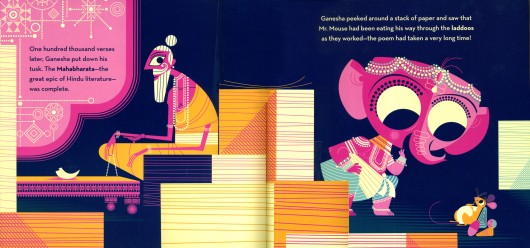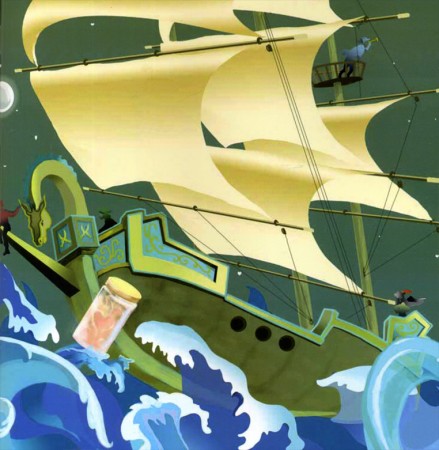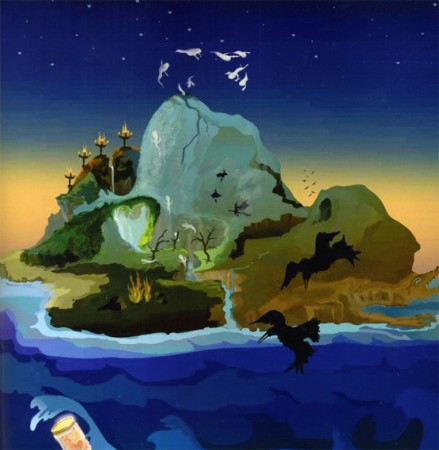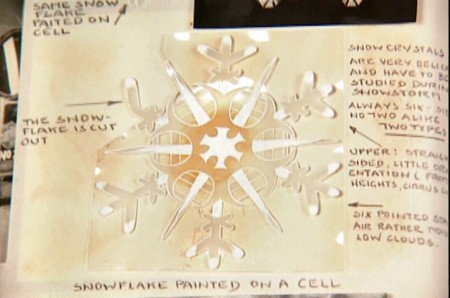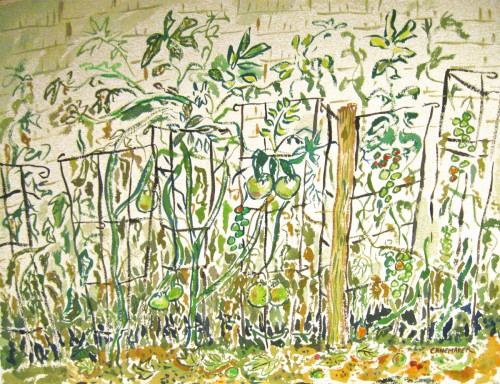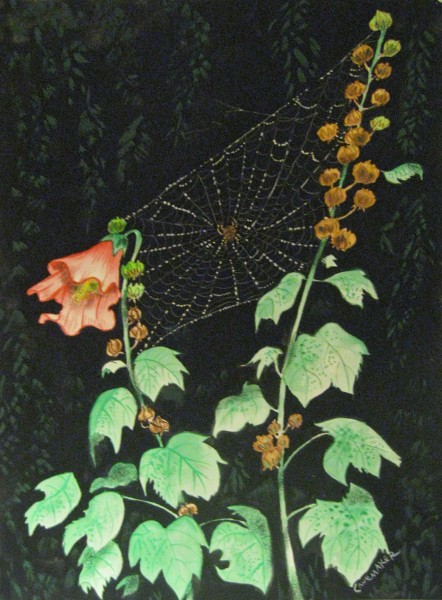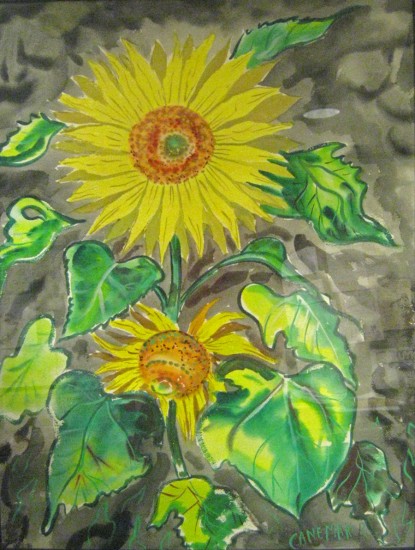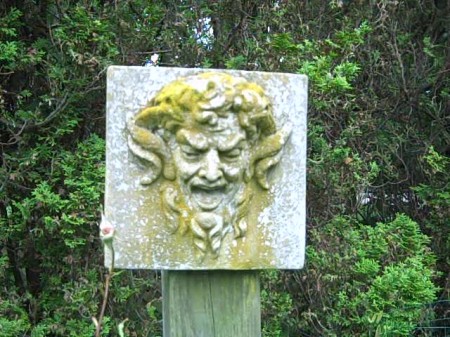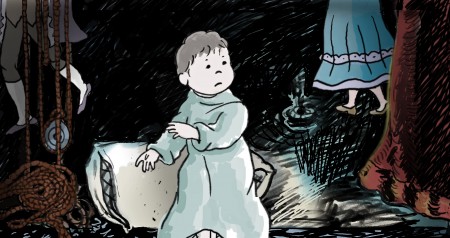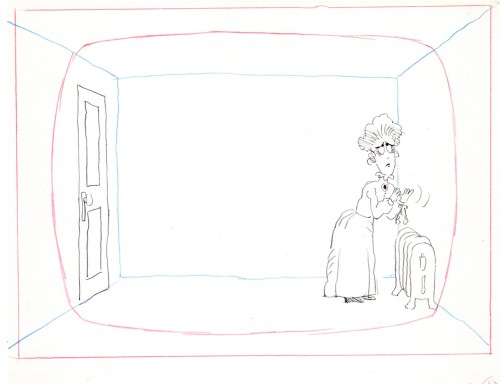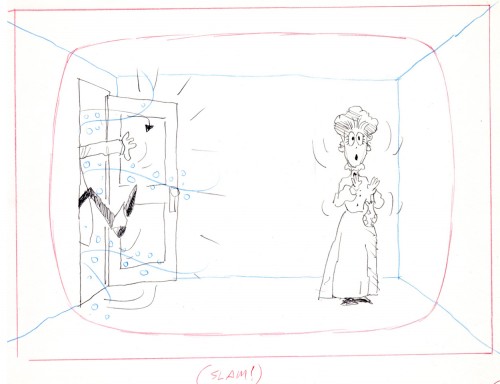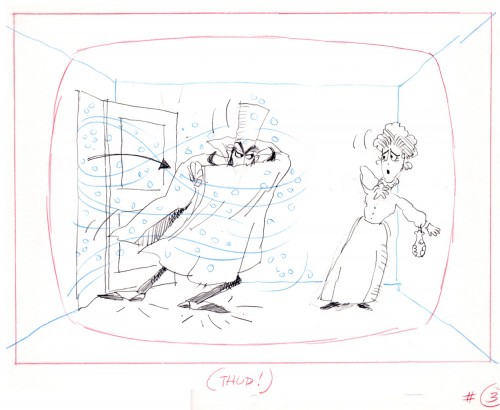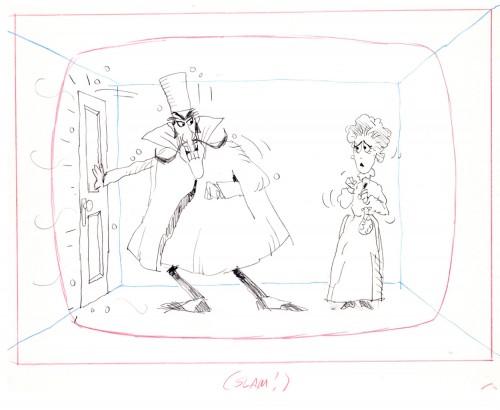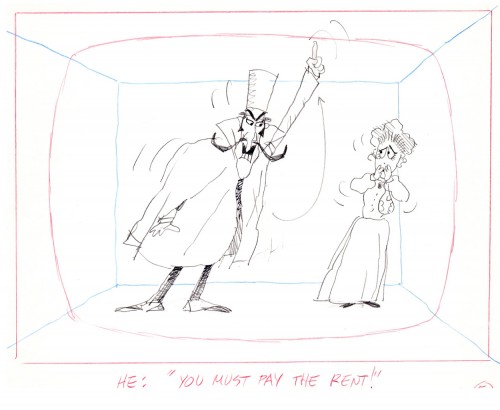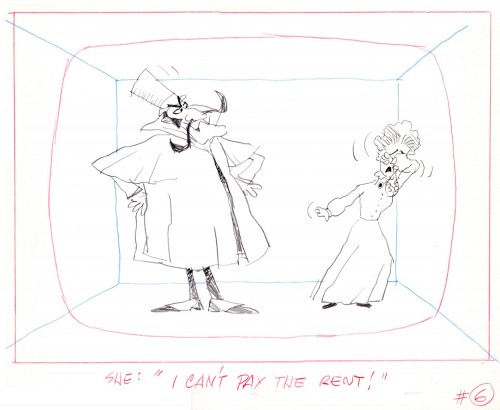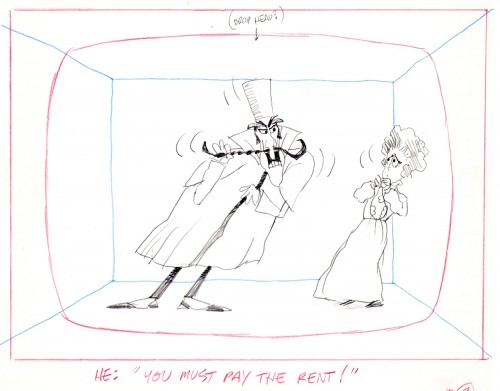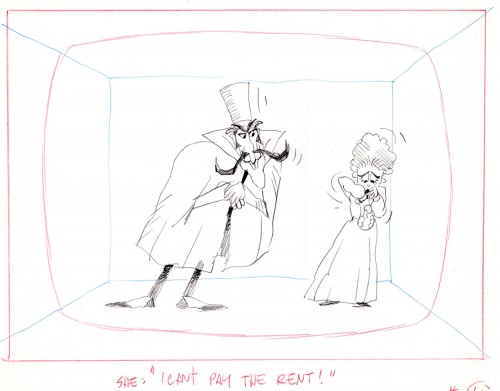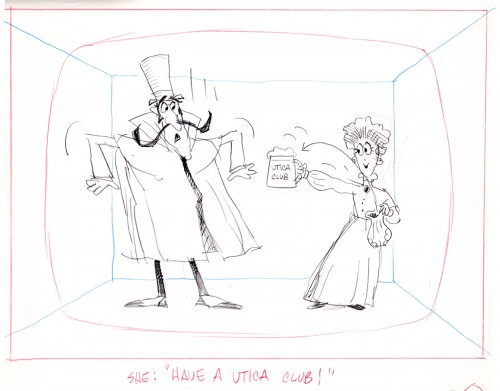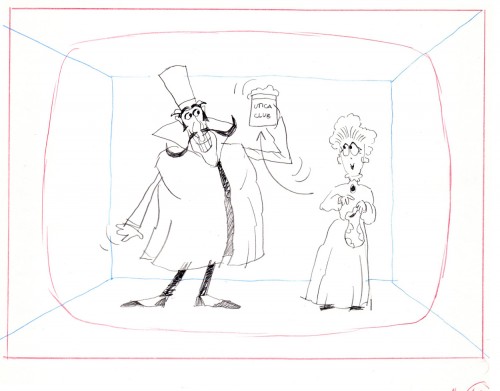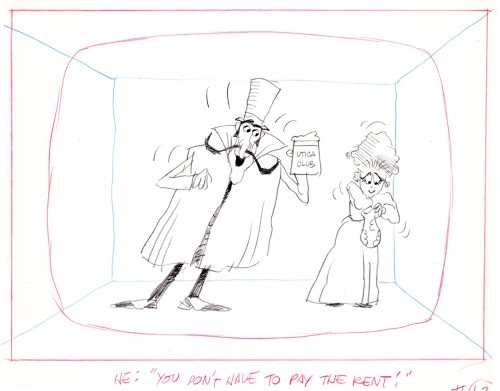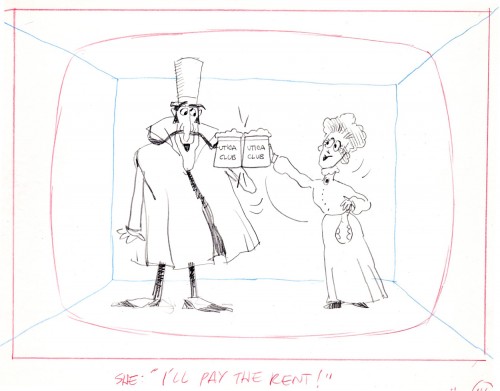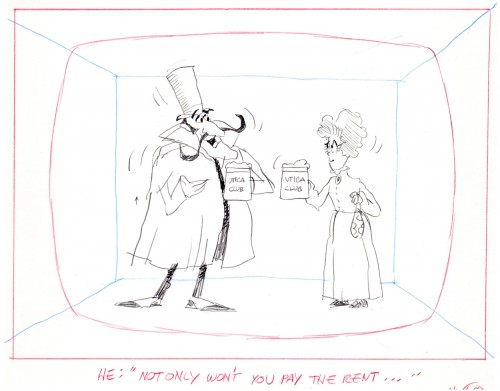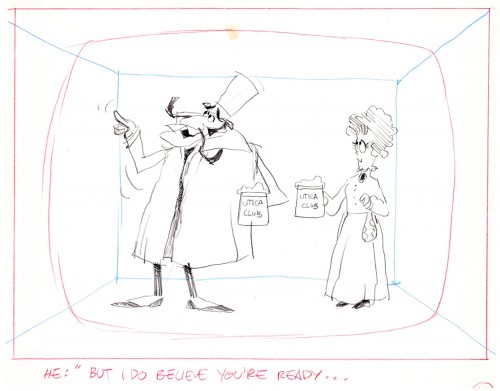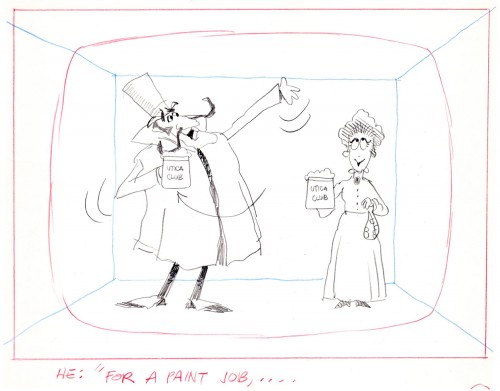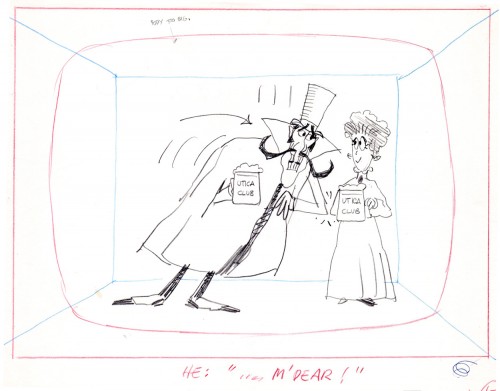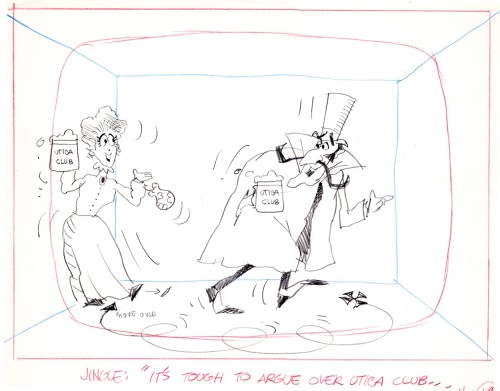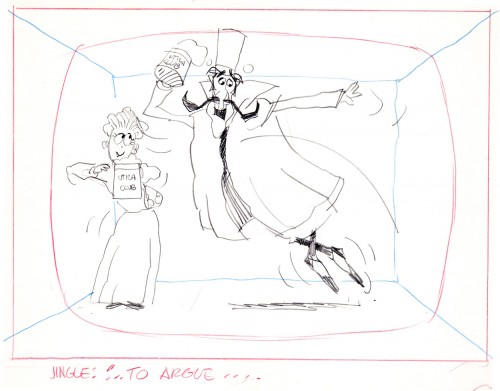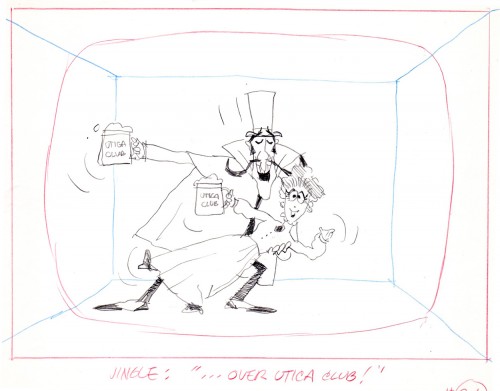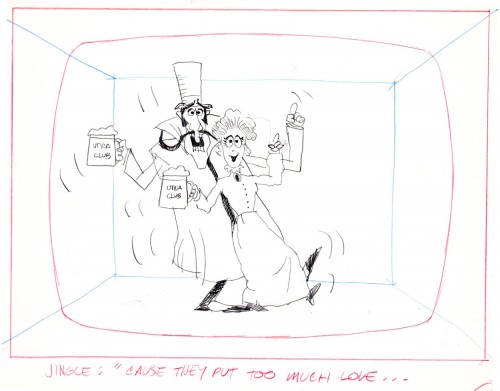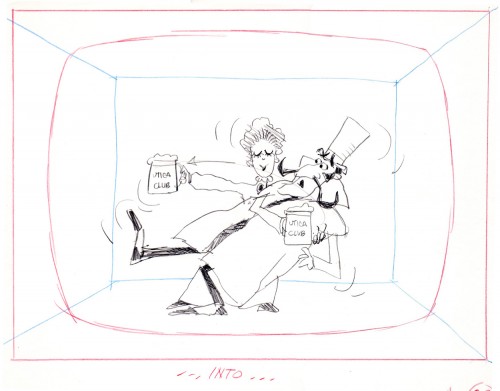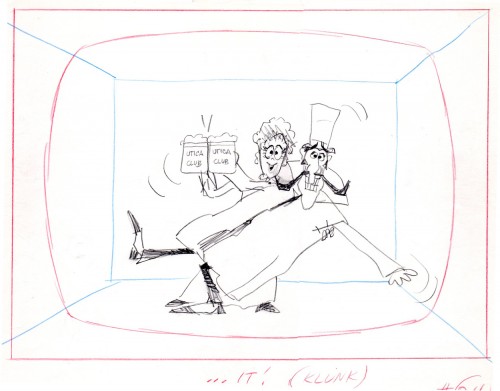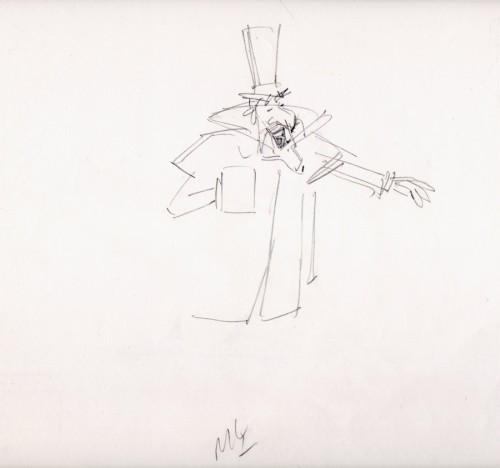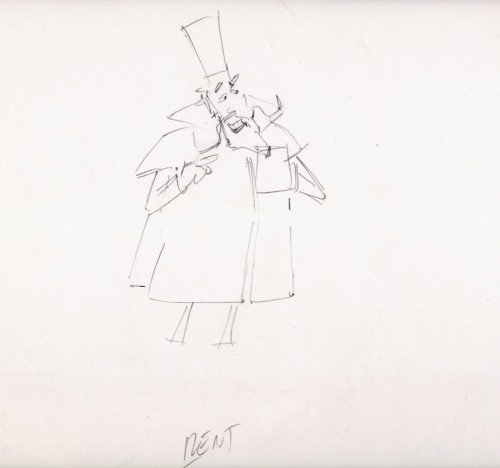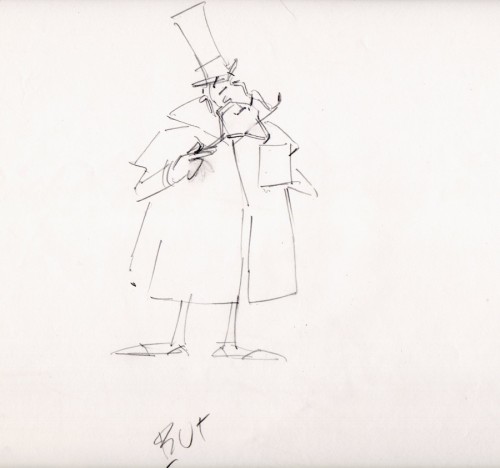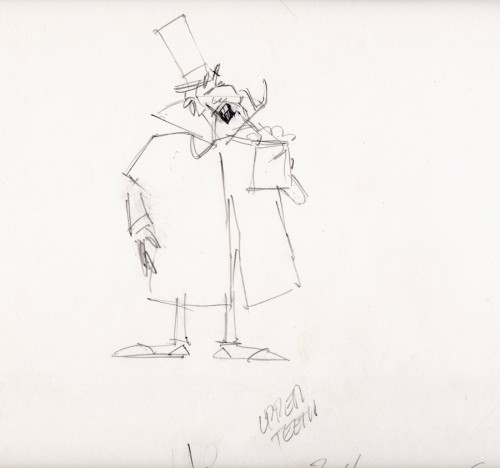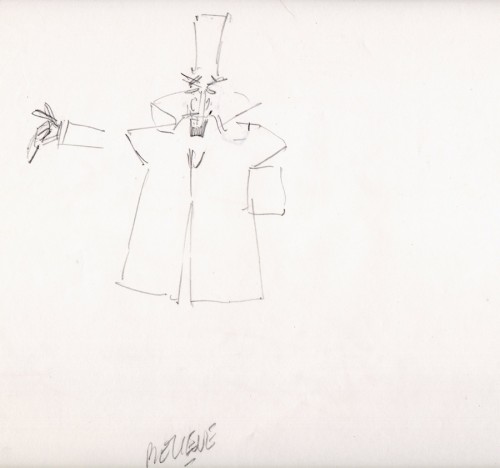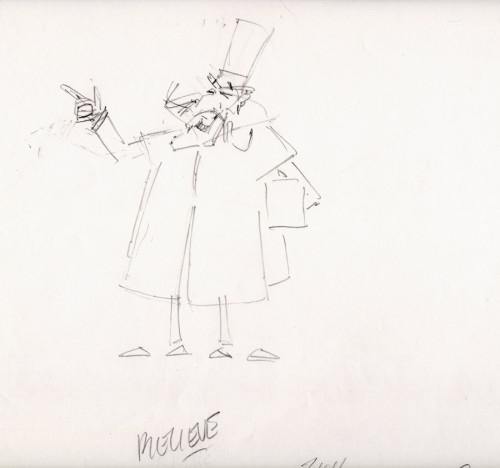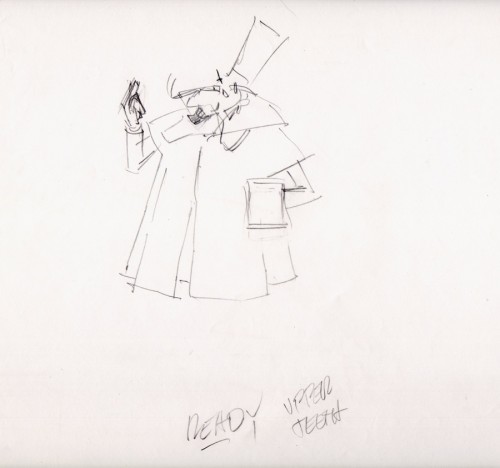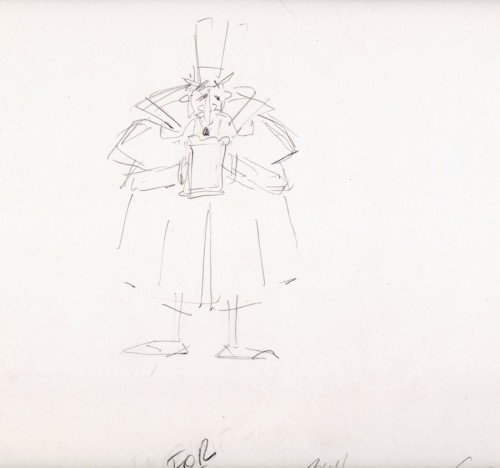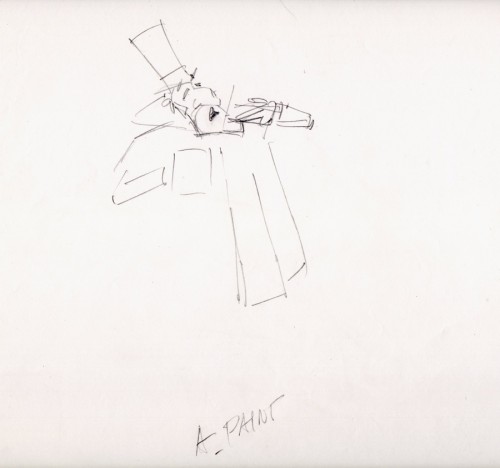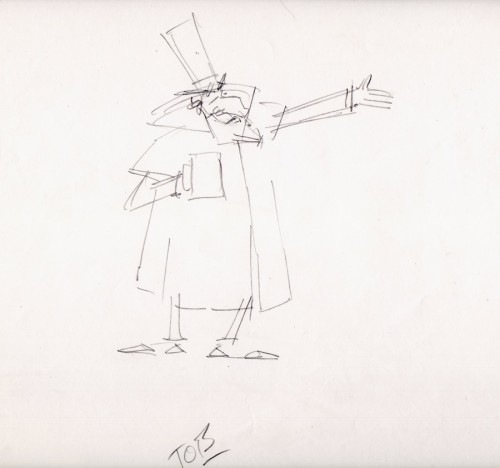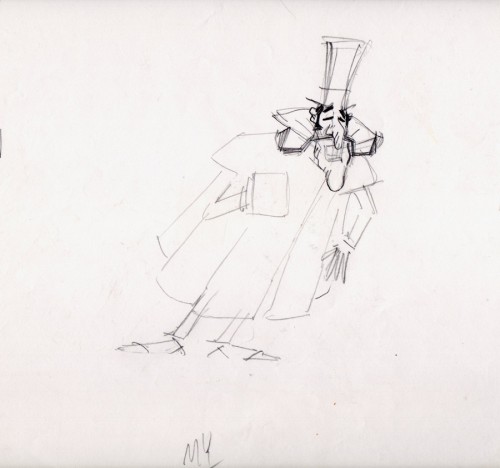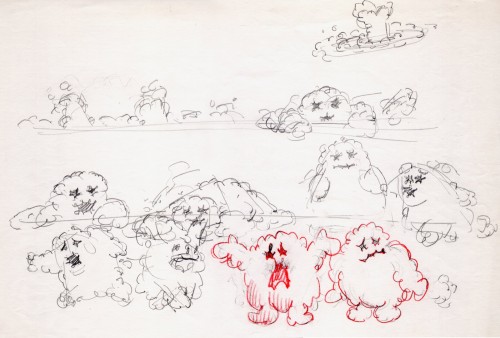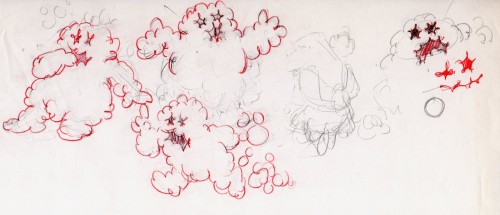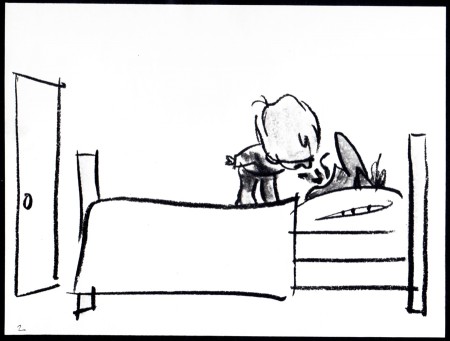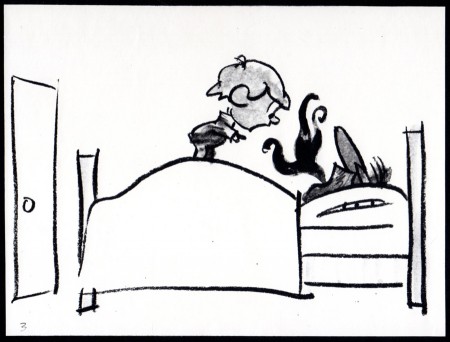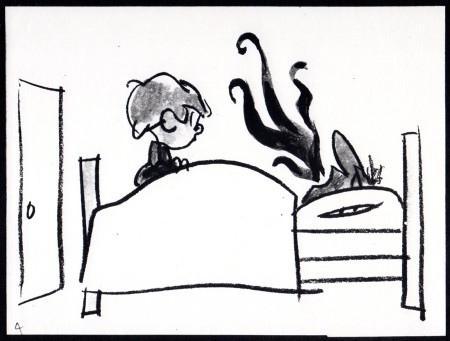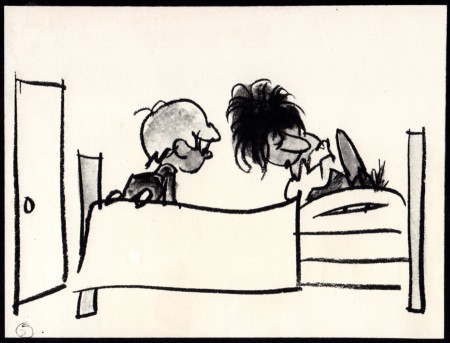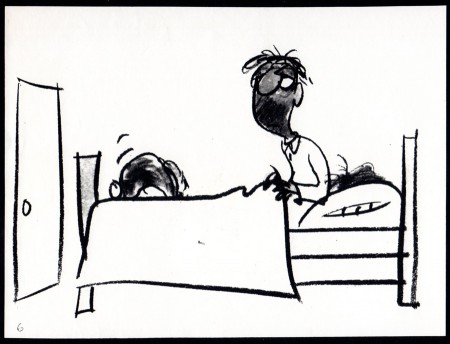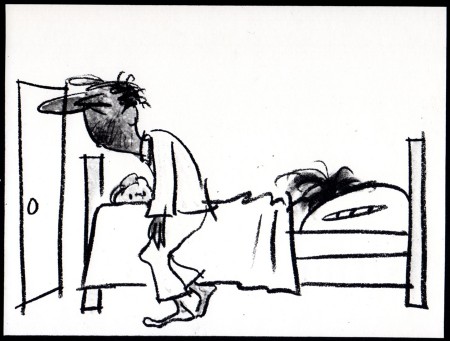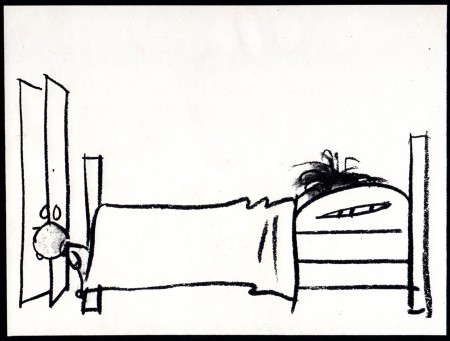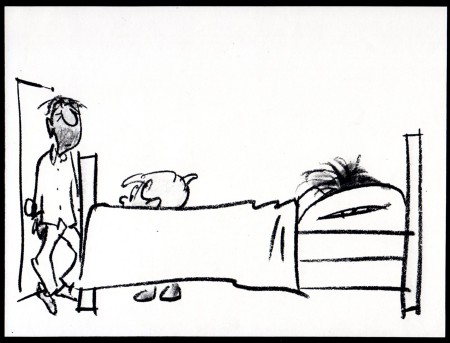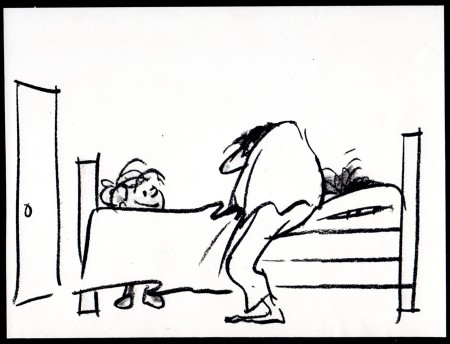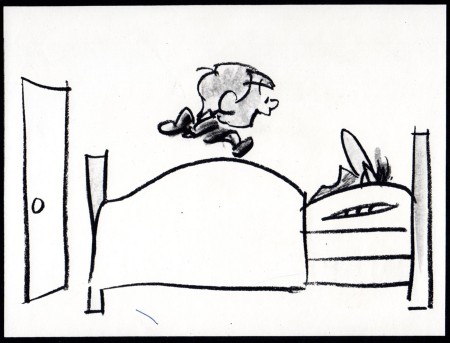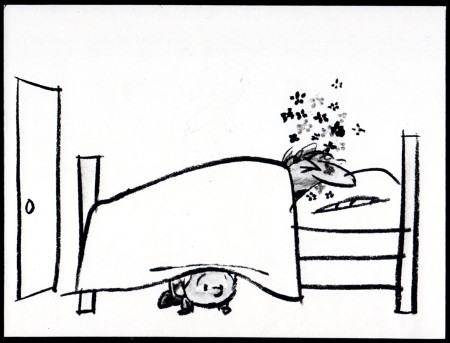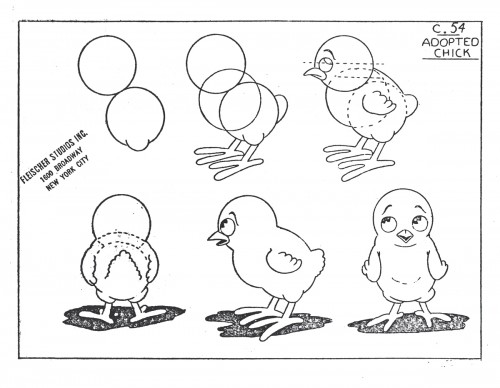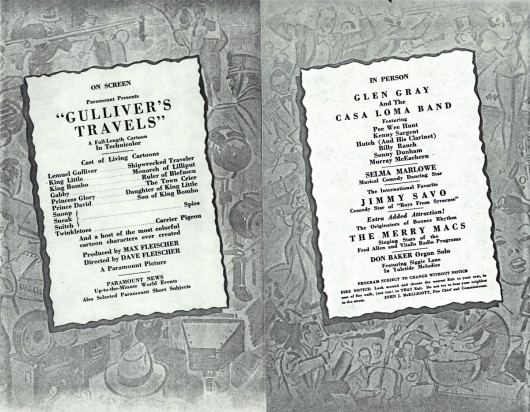Monthly ArchiveAugust 2012
Commentary 22 Aug 2012 08:03 am
Tissa David 1921-2012
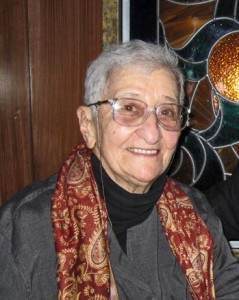
Tissa David was 91 last January.
Tissa David died last night.
In the past month, it was discovered that Tissa had a tumor which formed on her brain and was growing rapidly. She went home from the hospital, rather than experience a difficult operation, which she, at the age of 91, wouldn’t survive. It would be better to go out gracefully.
I visited her several times a week, if I could. Our conversations amounted to my being as cheerful as possible remembering as much as I could and discussing old friends and good times. I tried to sound as gossipy as I could, and Tissa enjoyed that. We also talked about animation: the mechanics of animation and different styles of animation. Her memory was clear as long as I was talking. When she tried to answer a question, the memory didn’t work, and Tissa would just say, “I don’t know. I don’t know.”
Last night, while I was out, her good friend and caretaker, Susan Davis, called leaving a message for me to return her call to Tissa’s apartment. I had intended to visit Tissa again today, Wednesday.
Tissa died yesterday evening, August 21st, in her Manhattan apartment at 7:35 PM.
To give some background information about Tissa David, I’m reposting this Millimeter article that John Canemaker wrote in 1975. I’ve added some to it.
- The 1975 issue of Millimeter Magazine is an animation issue. There are a number of enormously informative articles. I was rereading a copy of the magazine, this past weekend, when I came across the Close Up section, wherein a couple of bios appear.
I’d like to show one for Tissa David that was included. I assumed John Canemaker authored the piece; there is no byline. When I asked him, he responded thus: “I wrote the article on Tissa. The quotes are from my first formal interview with her. It was for Millimeter when I was the animation editor and put together special animation issues.”
Tissa looks so young in that photo.
-
“I am a frustrated comedienne, for sure,” Tissa David will tell you, only if you ask. “I am a clown. If I weren’t shy, I’d probably be on the stage.” Instead she is an animator, one of the world’s best and busiest, and one of the few women to have reached the top in the traditionally male-dominated animated cartoon field.
She joyfully toils in her East-Side New York apartment, a warm, plant-filled place that often smells of baked apples. Classical music swirls quietly from a radio and the glow cast from the light under her animation board gives her the look of a sorceress.
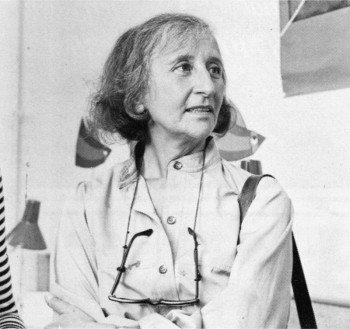 The lady has class—a fact one gathers upon first meeting, but a fact that is reaffirmed by catching a look at the creatures she is conjuring to life on her drawing board. The graphic line is strong and free, yet elegant (as is the artist); and when the drawings are flipped, the creatures move through their paces with a deliciously droll humor, a wit that is uniquely Tissa David’s.
The lady has class—a fact one gathers upon first meeting, but a fact that is reaffirmed by catching a look at the creatures she is conjuring to life on her drawing board. The graphic line is strong and free, yet elegant (as is the artist); and when the drawings are flipped, the creatures move through their paces with a deliciously droll humor, a wit that is uniquely Tissa David’s.
As a child in her native Hungary, Tissa saw Disney’s SNOW WHITE and thought (as so many others have thought after experiencing that film masterpiece), “Now this is something I want to do.” After graduating from art school, she became an assistant animator at Magyar Film Iroda in Budapest; a little more than a year later, in 1945, she was a co-owner of the Studio Mackassy and Trsi supervising all phases of production including story and camera and was sole animator of the puppet and cartoon films.
She left Hungary in 1950 during the height of the Stalin regime, and finally landed in Paris.
Jean Image Productions hired her in September 1951 and for two years she read sound tracks, planned layouts, animated, and did the entire editing of the feature-length, BONJOUR PARIS (1953). That studio closed and Tissa animated at La Comete next, a studio that had been Paul Grimault’s.
“I had absolutely no relatives outside of Hungary except in the United States. So I asked for a visa in 1950. It took at that time five years to get a visa, that was still the quota system. So I came to New York…I loved the U.P.A. cartoons. I decided I wanted to work in that studio.” In 1956, the United Productions of America’s New York Studio was the last tenant in a brownstone on Fifth Avenue and 53rd Street slated to be torn down for the construction of the 666 Tishman Building. There was a French girl in the UPA studio and so she introduced me,” Tissa recalls. “I had no sample reel. I went in once to make a sort of tryout. I was scared; I didn’t speak English, so I was just waiting, waiting, and Grim came by…Grim Natwick is the history of animation and I can rave about him. He created Betty Boop and animated the character of Snow White all the way through. UPA had an awful lot of work and they needed an assistant to Grim.”
At that initial meeting, Natwick boomed, “Now, you know what animation is!” Tissa quietly answered, “Animation is—animation.” Natwick laughed, “You can’t argue with that!” and thus began a professional partnership that lasted twelve years. “Isn’t it strange,” says Tissa today, “that SNOW WHITE got me into animation and I really learned my animation from Grim. I know a great deal about animation, I know I know, because even today I don’t do one line without something in my brain Grim told me.”
After UPA closed in 1958, Tissa and Grim freelanced as a team on countless TV commercials, and since Grim’s retirement, Tissa has soloed successfully and most notably on several John Hubley projects, i.s.: Of Demons and Men (1970), Eggs (1970), Children’s Television Workshop segments Cool Pool Fool, True Blue Sue, Truth Ruth and others, and Cockaboody (1973). Her latest animations include three CTW Letterman episodes, a scene in Shamus Culhane’s Noah’s Ark production, and over 110 feet of Hubley’s Bicentennial film, People, People, People. She has just completed some experimental animation fora Dick Williams project and is now starting, also for Hubley, a TV special based on Erik Erikson’s writings.
A description of Tissa David’s style of animation is difficult; for while it is a distillation of the Disney influence in timing, the UPA sense of humor-through-graphic-design, and the strong, poetic John Hubley mode, it also contains a different character, unique to Tissa David, that she calls the “female difference…If the same scene is animated by a man and by me, there will be a great difference, not in quality but in interpretation. John Hubley told me I have a fine sense for detail, not in the drawing itself because I make very loose drawings, but in a scene, in expressing feelings. I am a very intuitive animator—I never know when I sit down to work what will happen.”
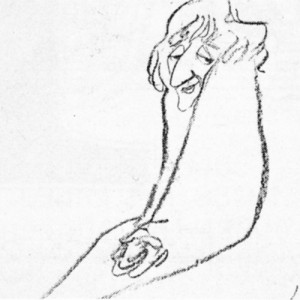 For all her gentleness, Tissa also contains an inner core of strength exhibited in her single-minded devotion to her art. Her opinions about that art, herself and other topics, is disarmingly to-the-point: “I believe very strongly that one must know how to draw,” she will offer on the subject of how-to-animate. “Even if you just animate objects, you must have a knowledge of drawing.” As for her struggles securing her place in animation, Tissa will admit, “…its very hard. Women can find work in animation if they have enough will to follow through and really do it. Even today, I’m always saying if I keep busy long enough, I will become a good animator.”
For all her gentleness, Tissa also contains an inner core of strength exhibited in her single-minded devotion to her art. Her opinions about that art, herself and other topics, is disarmingly to-the-point: “I believe very strongly that one must know how to draw,” she will offer on the subject of how-to-animate. “Even if you just animate objects, you must have a knowledge of drawing.” As for her struggles securing her place in animation, Tissa will admit, “…its very hard. Women can find work in animation if they have enough will to follow through and really do it. Even today, I’m always saying if I keep busy long enough, I will become a good animator.”
At the time this piece was written, Tissa was completing work on a pilot for Dick Williams’ film, Raggedy Ann & Andy; this one minute piece got Dick the film over Joe Oriolo and Shamus Culhane. She would thereafter work on John Hubley’s Doonsebury Special (just as he died mid film); and she was to animate for R.O.Blechman’s Simple Gifts.
Since that article was written, Tissa had animated a good part of The Soldier’s Tale for Bob Blechman. It won the EMMY Award. For me she worked on many of my half hour shows. The Marzipan Pig was made from her storyboard, and she animated the entire half hour film.
I’ll write a longer piece in a few days and will add some photographs.
Needless to say, this is very sad for me.
Books 21 Aug 2012 07:06 am
Ganesha’s Sweet Tooth & Mama’s Love
- I received the children’s book, Ganesha’s Sweet Tooth, illustrated by Sanjay Patel and written by Emily Haynes.
It’s the story of the elephant, Ganesha, and how he breaks his tusk on a jawbreaker. With tears in his eyes, he learns to use the tusk as a pen to write, and he ultimately writes The Mahabharata, all one hundred thousand verses. It’s the great epic poem of Hindu literature.
Like every other book sent me by the excellent publisher, Chronicle Books, I am a fan of Sanjay Patel‘s work. I’ve reviewed his work very favorably, for good reason. It’s excellent. Here are a couple of past posts: #1, #2, #3. The Ramayana is still his masterwork, but it’s nice to see material like this on the children’s shelf.

This is the cover of the book.
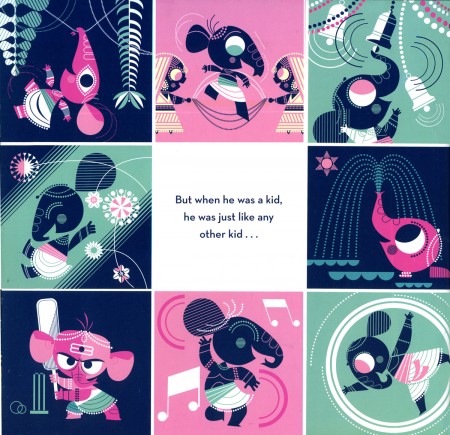
Many of the images are single pages, like the one above.

Most are doubled page spreads.
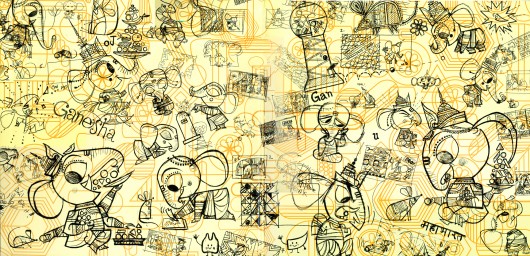
The drawing on the front inner cover. There’s
another, different one in the back of the book.
Mr. Patel is an artist working for Pixar as an animator and storyboard artist. He’s made quite a name for himself with these beautiful publications. Chronicle books is the perfect home for him. Their books always feature wonderful detail and care.
Note that this book will officially be released on Sept. 19th, when I’ll mention it again.
I’d love to see Mr. Patel’s designs and art animated.
- Here’s a very different kind of book.
I received it in the mail; it came from Laura Bryson. Laura worked for me on a number of my half hour shows. She did Bgs on The Red Shoes, The Marzipan Pig and several others as well. I think The Strongest Love is Laura’s first book. She illustrated Katie McDonnell‘s verse story about a mother’s love. The book seems to be for a very young audience, but the illustrations are timeless. he publisher is Turn the Page.
Laura certainly wasn’t looking for me to review it; she was just excited to share it with a friend. However, I have to share the news (and maybe sell a book or two for her.)
Here are a couple of sample pages (every other page is illustrated against others that include the written, printed verse.)

The book’s cover
Animation &Animation Artifacts &Disney &Hubley &John Canemaker &repeated posts 20 Aug 2012 05:53 am
Fantasia FX – Schultheis – recap
John Canemaker recently completed his latest book about Herman Schultheis and the effects department at Disney’s during the early 40s. It, hopefully, will be published in late 2014. This encouraged me to pull up this piece I posted in Sept/2009. It’s amazing how much information I was able to cull from the photos I found on the DVD.
I’m pleased with this post and am glad to repeat it for those who might not have seen it. John’s book, by the way, is one I’m looking forward to reading. He’s written a bit about it on his website.
- Herman Schultheis was an effects animator who worked on Fantasia. He kept a tight record of the effects they were creating from 1938-1941 and a photo display of how they were done. Schultheis disappeared in 1954 while trekking through Central America, and the notebook was forgotten until his wife’s death in the early 1990s, after which it was discovered by Howard Lowery behind the couple’s bedroom wall.
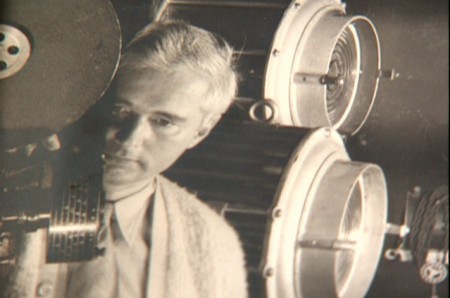
(Click any image to enlarge.)
Herman Schultheis created the book of charts and photos
which gives us a link to the many creative effects in the film.
The book is on display at the The Walt Disney Family Museum. It’s also been digitized so that visitors are able to go through the book, enlarge photos and view it page by page. An interactive display.
Prior to the discovery of the book we were able to figure out a few of the effects. One Disneyland show, in fact, recreated the bubbling lava scene from the Rite of Spring sequence.
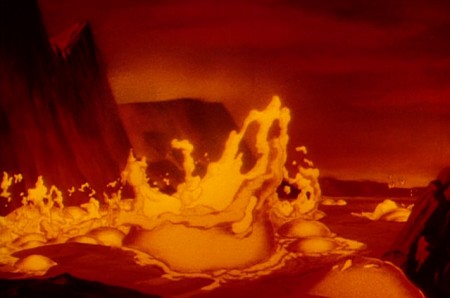
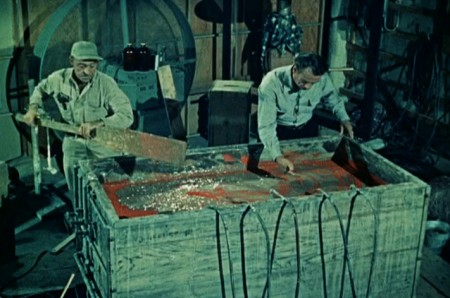
Josh Meador recreated the slow motion shoot of the
boiling concoction used to develop the bubbling lava.
However, the book revealed so much more than we’d understood
about how the superb effects had been crafted.
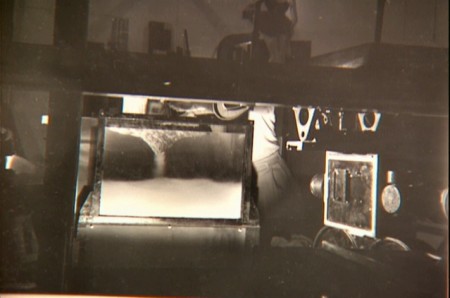
Using a vat of water, they were able to
drop ink into the liquid and film it in slow motion.
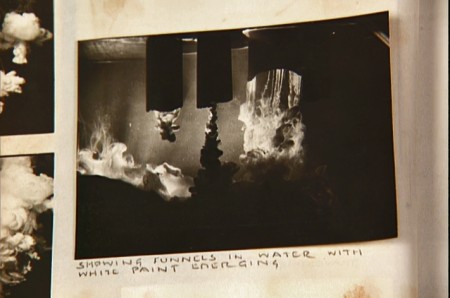
A photo of the ink spilling into the water behind built-in mattes.
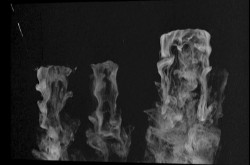
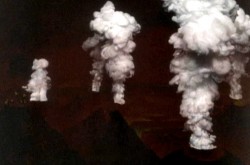
Taking the shot of the ink, they then turned it upside-down.
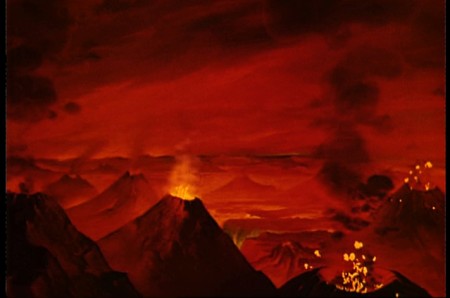
They then superimpose the “smoke” (or ink) over the volcanoes.
This same effect was used in Close Encounters of the Third Kind
to create clouds when the alien ships were moving in on the
farmhouse where the boy and mother lived.
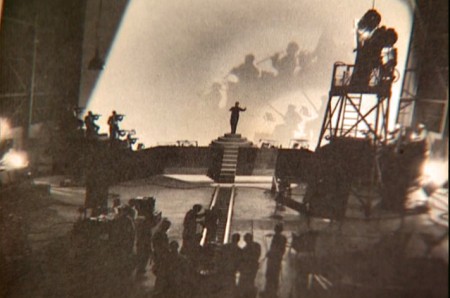
The orchestra was shot on a set with strong, planned shadows.
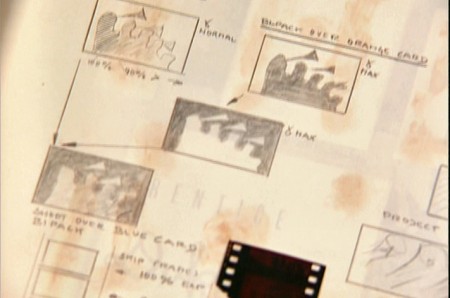
All these shots were orchestrated and planned for color effects.
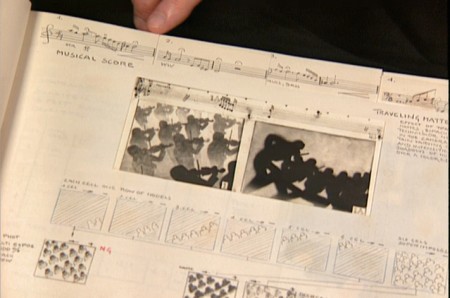
They were also catalogued by Schultheis who kept close
track of the music, as well, in his book. You can see a
page by page breakdown of the score at the top of the page.
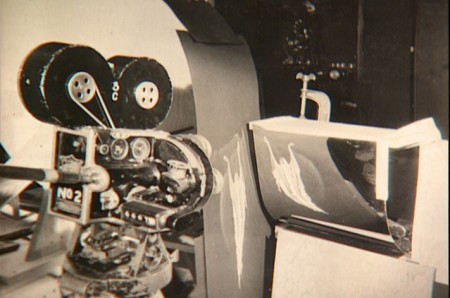
You can see the highly polished sheet of metal (middle left) which reflected
and distorted the animation drawings. This is what the camera photographed
in some of the scenes during the Night on Bald Mountain sequence.
It was also used for the fire in Bambi.
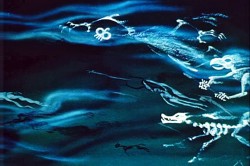 1
1 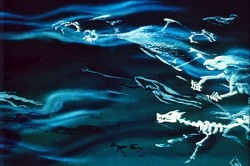 2
2
This scene’s ghosts were shot using that distorted metal reflection.
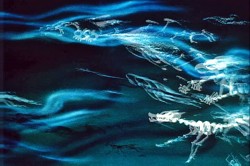 2a
2a 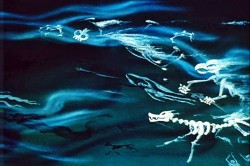 3
3
The ghosts also used a form of cross dissolve.
John Hubley explained to me how that was done, and
we used the technique in Everybody Rides the Carousel.
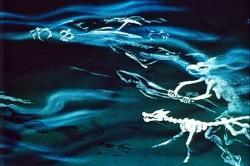 4
4 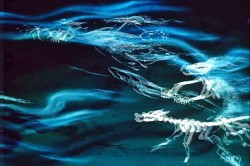 4a
4a
They shot the entire scene at 50% exposure. Then they went back
to the beginning and reshot the entire scene again at 50% exposure.
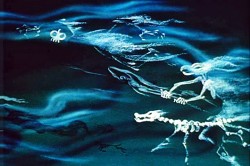 5
5 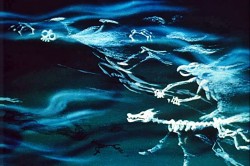 6
6
However on the second shoot, they started by shooting a black frame.
This made #1 fall where #2 should have been, #2 for #3 etc.
This creates a ghostly dissolve effect.
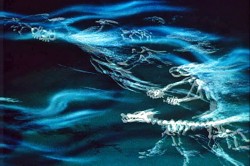 6a
6a 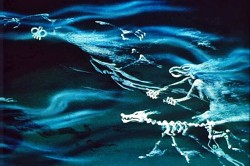 7
7
All of the drawings labelled with an “a” are the double exposures:
2a, 4a, 6a
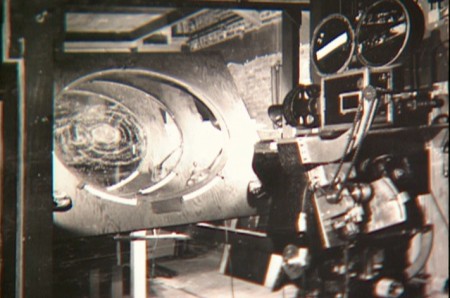
A make-shift circular multiplane camera was built.
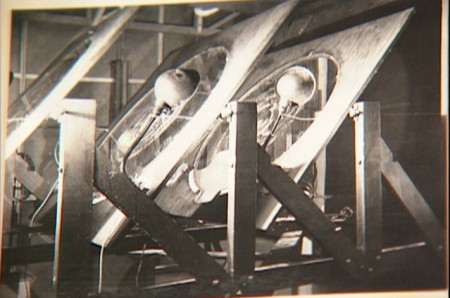
Created out of wooden sheets with holes cut out,
placed so they could shift angles, they were designed to
allow revolving artwork in the circular cut outs.

This allowed shooting scenes such as this shot of
a spider web as the camera moved around it
while dew glistened off of it.
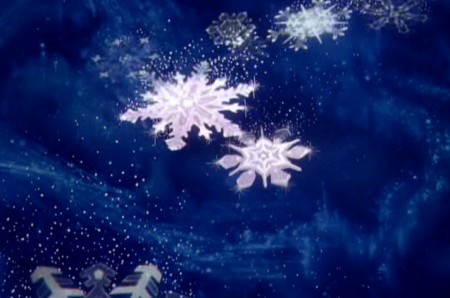
The spinning snowflakes are well explained in Schultheis’ book.
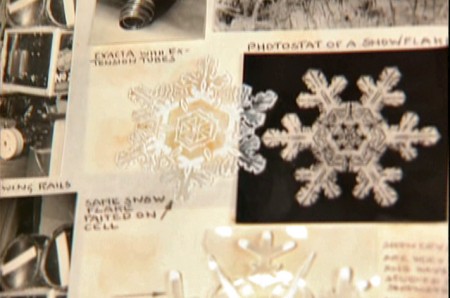
The snowflakes had a detailed construction.
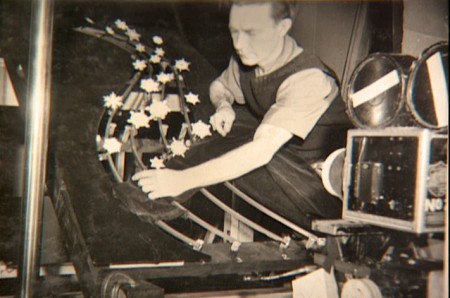
The path of action was intricately defined.
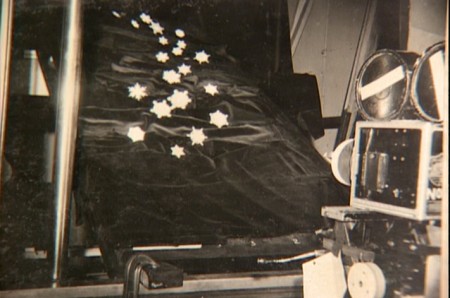
The snowflakes were shot against a sheet of
black velvet hiding the wire guides.
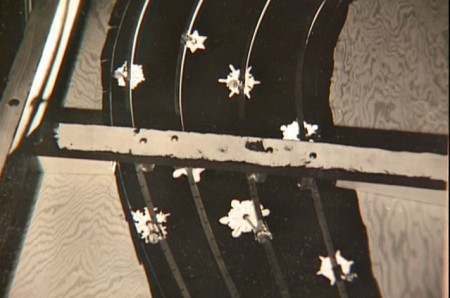
They were shot in tight closeup. From below you can
see the turning gears they were constructed on.
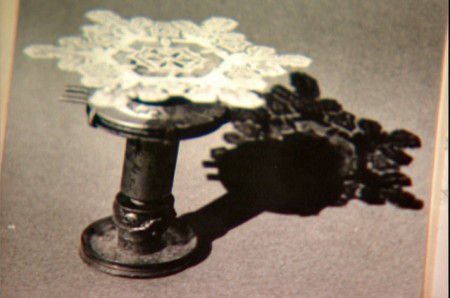
Each snowflake was built on a turning gear
so that they could revolve in their path of action.
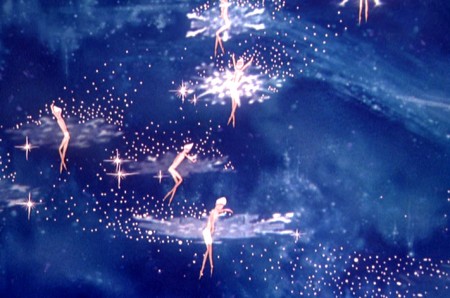
Burn these snowflakes over the multiplane background
and add matching 2D animated fairies within each snowflake,
and you have the finished scene.
John Canemaker &Photos &repeated posts 19 Aug 2012 07:00 am
John & Joe’s Garden
- Last year at about this time, Heidi and I went to visit John Canemaker and Joe Kennedy at their wonderful Bridgehampton house. That weekend I was so overwhelmed by the flush and beautiful gerden as well as the wonderful floral paintings John had done. I reported it on this blog, and was quite pleased with that post.
This weekend we’re repeating the excursion and have come to a different trip. For one, as Joe told me, the flowers bloomed much sooner this year, including those that usually bloom late, probably because of the peculiar weather we’ve been having. Consequently, the garden looked very different this year. It is now very green without much color.
This year we had more than overcast clouds affecting the weather. Rain stayed with us on much of Saturday. I didn’t mind very much, but there was little opportunity to walk through the garden with the ground so wet.
I’ve taken a few pictures this weekend and will add those later this afternoon once I get home, but for now I’m repeating last year’s post (with some minor changes).
- This past weekend, Heidi and I spent a lovely quiet time in Bridgehampton at the invitation of John Canemaker and his companion, Joe Kennedy. It made for a very restful and enjoyable time despite the grouchy weather.

The garden gives you the illusion that it’s larger than it is.
Even walking in it you feel that you could easily get lost in it.
The first dominant site you take with you as you visit the house is the amazing yard and the enormously colorful and tender care Joe and John have taken to cultivate their garden of a back yard. It’s stunningly beautiful. It feels almost as though these plants grew naturally next to each other and happen to take the shape it’s taken. The amount of weeding and nurturing and debugging is left completely behind as you bask in the warm glow of this garden with its variety of flower and shrub. It’s beautiful and peaceful and inviting. I couldn’t help myself over the course of the weekend; I took many walks in the area and sat and enjoyed it. I loved it.
The second thing that captivated me during the visit was a painting John had done. It sat on the wall of the guest room we stayed in. In the first few hours in the house I kept coming back to the painting. I liked it enough that I took out my camera and photographed it. As I did, I realized that there were other smaller paintings in the room, and I found them almost as lovely. There’s no doubt John has been taken with the amazing garden out back, and this has helped to color these fine watercolors.
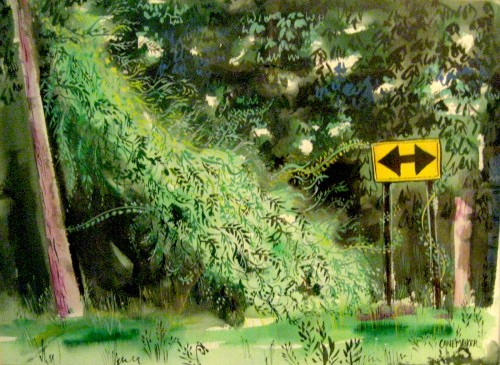
This painting obviously is not from the garden (given the road sign).
However, one can’t help but feel that the life in that garden spills over
into this painting – as it does in all the others.
At some point in the weekend, I asked John if he minded my photographing some of the paintings in the house and posting them on the blog. John, as always, was quite open to anything I wanted to do, so I went about quickly taking some photos. I also intended to mix in pictures from the garden. After all, I see these paintings and the flora as intermingling and working together in a lovely way.
There were some problems. The paintings lost some of their verve when photographed. The delicate colors were lost, and the shape of the pictures altered. (The lens of the camera seems to have slightly distorted the frames of the images.) I saw the pictures in some way influenced by Mary Blair’s work, but John took her colors and softened them. (The brashness of Blair’s work has always bothered me.) In the end, I found myself adjusting the pictures slightly to try to give them a bit of the feel of the originals, but I’m not sure I’ve succeeded. However, better you should get to see these images than none. My apologies to John.
So, I hope you enjoy the quick tour.


One of the larger paintings John had in his office, downstairs.

A beautiful flower that opened the day we arrived.

Heidi sitting on the porch just to the front of the garden.
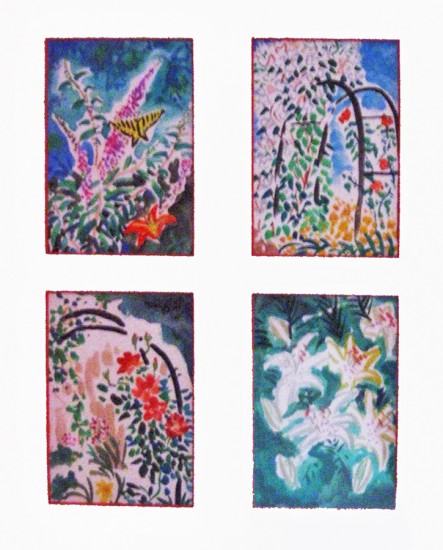
John has done many small quickly sketched watercolors.
Here, you can really feel the distortion of the camera’s lens.
Again, my apologies to John.
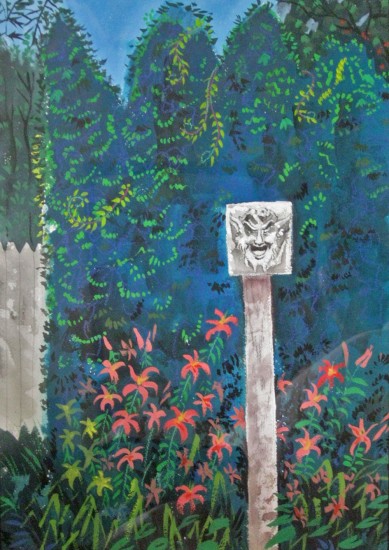
I had a hard time photographing this one.
The reflections in the picture frame’s glass was difficult to avoid.
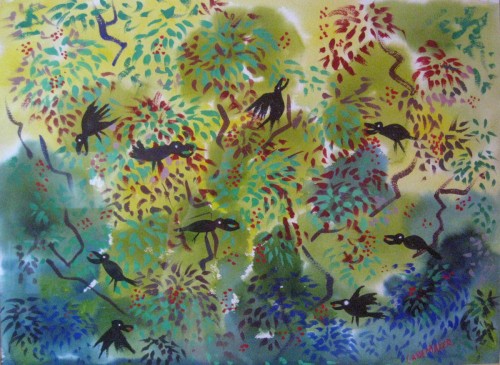
Another painting that just totally caught my attention.

Finally, a lovely little statue sitting just off the porch.
It’s a stone rabbit that once belonged to Bill Tytla.
Adrienne Tytla, Bill’s widow gave it to John as a gift.
Many thanks to John Canemaker and Joe Kennedy for a lovely weekend and all the wonderful inspiration, not only in the paintings but in the garden, as well. It was more than a small retreat.
Well, it’s later that afternoon, and we’re home. But I’m beat.
There are too many pictures I’ve taken and the post would be endless if I added them here, so I’ve decided to post a couple of pics of John’s paintings, and I’ll save the remainder for next Sunday. I’m sure you won’t mind. Though they are good pictures. See John, Joe and Heidi sharing a kitchen as they make linguine with clam sauce; see the four of us romping on the beach; see more pictures of the garden sculpture Bill Tytla’s widow gave John and Joe for their garden. And see some great pictures of the garden in the rain. I’m sure you’ll want to return next Sunday for that. (or not!)

Here’s John, Heidi and Joe outside their house.
It looks as though they’re greeting us, but in reality
Heidi and I are about to leave on Sunday afternoon.

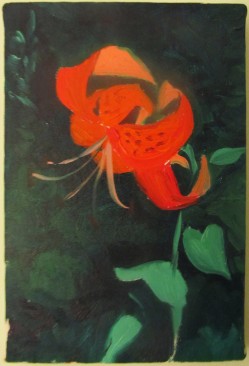
These two small paintings by John were
hanging in the guest bedroom we occupied.
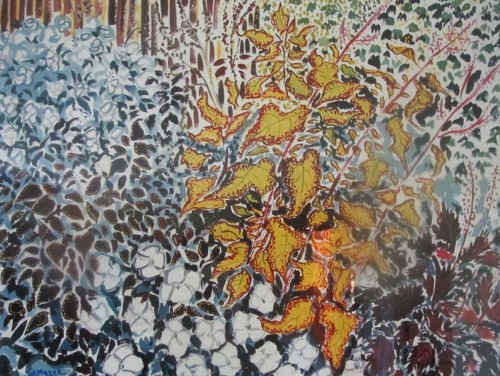
This gem of a painting hung over the mantelpiece
in the living room. It belonged there.
Commentary 18 Aug 2012 04:11 am
Reaching into the Grabbag
In truth, I’ve been wholly absorbed and entertained by the political Presidential race. The choice of Ryan for Republican VP just made the whole thing so juicy, it’s all I can watch on tv. Even the Yankees have taken back seat to Chris Matthews, Joe Scarborough, et al. It was fabulous watching Ann Coulter throw a hissy fit after a Romney aide talked about RomneyCare in Massachusetts. She screamed on Hannity’s show demanding that the aide get fired. Hilarious and wonderful. A real Reality show.
I’ve had to wait a full week to be able to post this, sorry. However I couldn’t resist sharing it, and by now, you’ve probably all seen this . . .

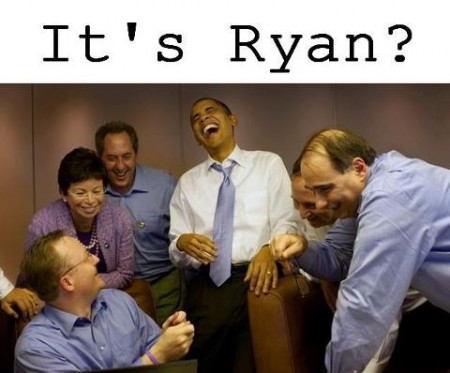
Right after the announcement that Ryan was the Republican choice for VP,
this came in my email.
Spam
of a sort.
But pretty funny (and accurate).
________________________
Just released this week is the trailer to Toys in the Attic a mixed media animation feature directed by Jiri Barta. It was made in the Czech Republic. The film will play in NY next weekend as part of the International Children’s Film Festival. That will take place on:
Saturday & Sunday, August 25-26, 11:00am
at the IFC Center.
The English version of the film stars the voices of Forest Whitaker, Joan Cusack and Cary Elwes and is being released to theaters on September 7th.
Here’s that trailer:
________________________
- Movies I’ve seen this week are numerous.
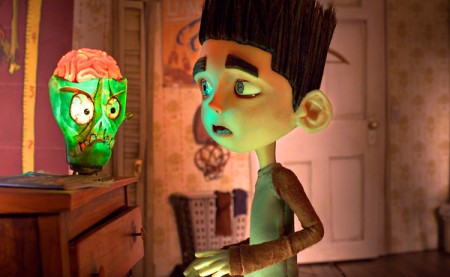
It all started with ParaNorman, which I kinda liked even though I didn’t find it as dramatic as I would have liked. The pacing seemed a little stodgy until the big climax at the end. And then it turned a bit too preachy in its obviousness. However, the animation is slick almost to the point where it vies with cg for fluidity. I still like my puppet animation in the Ray Harryhausen mode; I want to see the fingerprints on the puppets. George Pal seemed to have it down perfectly, and there was something to the great design of Pal’s animated films. No other like them, he was a total original. The ParaNormal characters look like they might have been designed for a Sony cg film.
However the film is very amiable and I have no real complaints. It beats out the Ice Age films.
You can see my full out review here. I also did a talkback at the screening with the two directors, Chris Butler and Sam Fell. They both seem to be intelligent and knowledgeable guys with a real love for animation.
The NYTimes‘ Manohla Dargis loved the film. “The story . . . is principally a vehicle for the movie’s meticulously detailed pictorial beauty, which turns each scene into an occasion for discovery and sometimes delight.”
The NYDaily News‘ Joe Neumaier wasn’t so thrilled with the film. “The 12-year-old boys who go to see “ParaNorman†— and who are the only ones who might enjoy it — should double up on the sugary treats to stay awake during this gorgeous-looking but zombi-fied stop-motion animated creep show. It’s as slow as a corpse, and half as interesting.”
The NYPost‘s lead critic Lou Leminick loved it. “So good, it’s scary.” ““ParaNorman’’ is probably the year’s most visually dazzling movie so far, and the stunning climax centering on an 11-year-old witch is too good to spoil.
Let’s just say this is the first movie this year that warrants a 3-D surcharge.”
- On Tuesday I saw a double feature:
The Campaign, the Will Ferrell and Zach Galifanaikis film which parodies the political battling going on around us as the two play two candidates vying for Congress. Shoddy politics play out even before either of them are elected. This is funny. Funnier than I expected but not as funny or serious as it should have been. 2 stars.
The Awakening was a British ghost story that just didn’t make it. Rebecca Hall‘s a fantastic actress as is Imelda Staunton. That didn’t matter for this film. It was dead on arrival. The ghosts in ParaNorman were more fun. 1 star for the great camerawork.
- On Thursday I saw a small little film; Robot and Frank did matter that Frank Langella
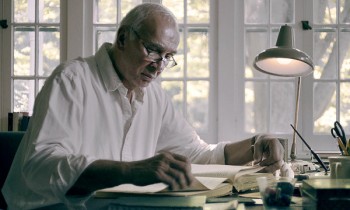 starred in it. This guy is a great talent and can bring anything to life, including this movie and the robot that works for him. (Though Peter Sarsgaard‘s voice of the robot makes it quite creepy.) It’s a sweet little film that’s pleasantly short. A nice metaphor between an aging forgetful man and a robot that wants to have his brain rebooted so he can’t testify against the inveterate thief. However, a couple of scenes, particularly one toward the end between Langella and Susan Sarandon make you realize how good the film should have been if the script and direction were better. 3 stars because it should’ve been better.
starred in it. This guy is a great talent and can bring anything to life, including this movie and the robot that works for him. (Though Peter Sarsgaard‘s voice of the robot makes it quite creepy.) It’s a sweet little film that’s pleasantly short. A nice metaphor between an aging forgetful man and a robot that wants to have his brain rebooted so he can’t testify against the inveterate thief. However, a couple of scenes, particularly one toward the end between Langella and Susan Sarandon make you realize how good the film should have been if the script and direction were better. 3 stars because it should’ve been better.
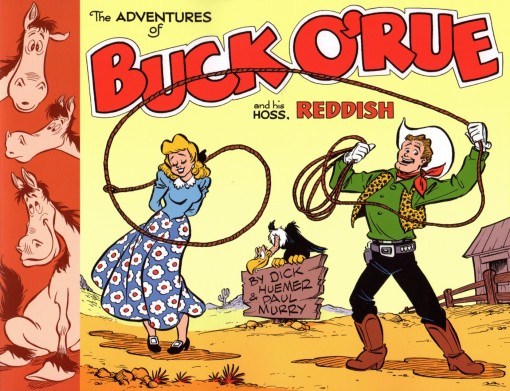 Thad Komorowski has an excellent article on his blog What About Thad which talks about Paul Murry and Dick Huemer‘s work.
Thad Komorowski has an excellent article on his blog What About Thad which talks about Paul Murry and Dick Huemer‘s work.
Thad is doing a followup to the new
The Adventures of Buck O’ Rue book currently out on the market. This book is a collection of rare comic strips by Huemer and Murry of a short lived strip.
The article includes plenty of Scrappy talk and links to many interviews.
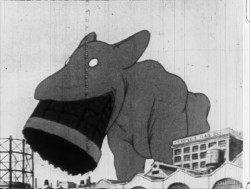 - Bill Benzon has an absolutely great piece on his blog, The New Savannah. He reviews the under appreciated Winsor McCay gem, The Pet. He takes a break from his detailed analysis of Disney’s Dumbo to review this movie (which he also adds to his post), and it’s worth the read. Please do it before Bill Plympton tries to rescue this film, too – or maybe I should have said wrest this film from the history of Winsor McCay.
- Bill Benzon has an absolutely great piece on his blog, The New Savannah. He reviews the under appreciated Winsor McCay gem, The Pet. He takes a break from his detailed analysis of Disney’s Dumbo to review this movie (which he also adds to his post), and it’s worth the read. Please do it before Bill Plympton tries to rescue this film, too – or maybe I should have said wrest this film from the history of Winsor McCay.
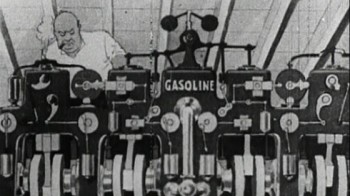 - Speaking of Bill Plympton and Winsor McCay, his bastardized version of McCay’s film, The Flying House, is now available on DVD. I’m included as part of an amateur documentary included saying how much I dislike what Plympton has done. The one good piece on the DVD is a fake documentary (also amateur production values) supposedly showing where McCay had lived. Among the ruins Bill finds a discarded McCay film, which turns out to be . . . . but tnen, this is the only good joke on the entire video, so I won’t give it away in case you persist in buying this.
- Speaking of Bill Plympton and Winsor McCay, his bastardized version of McCay’s film, The Flying House, is now available on DVD. I’m included as part of an amateur documentary included saying how much I dislike what Plympton has done. The one good piece on the DVD is a fake documentary (also amateur production values) supposedly showing where McCay had lived. Among the ruins Bill finds a discarded McCay film, which turns out to be . . . . but tnen, this is the only good joke on the entire video, so I won’t give it away in case you persist in buying this.
I’ve tried in vain to find a link so that you can buy the DVD. None are out there, so I assume it hasn’t been released officially. I’ve linked to Plympton’s own site where it should eventually show up. Go here.
- I’ve been going crazy (a good thing, I think) animating and reanimating and reanimating a scene from the opening sequence for POE. It’s taken a while, but I think I’ve finally gotten something of a style for the film which will enable me to incorporate all that Tissa’s done with new work from lesser animators and artists. In all honesty, the color styling and photography of the poor film I saw this week, The Awakening (see above), led me to it. That film was bad enough, but my mind was completely overwhelmed with thoughts of the work I was doing at home. Thank you Academy for getting me to that film, thank you Tissa for being so brilliant, thank you Daumier for all the inspiration, and, especially, thank you all you investors at Indiegogo for making it possible for me to work on this.
By the way, investors, the goodies are in process right now, and you should have the promised benefits heading your way, soon. I’m sorry for the delay.
Animation &Animation Artifacts &Bill Peckmann &commercial animation &Layout & Design &Models 17 Aug 2012 06:23 am
Peckmann & Schnerk’s Utica Club
Another spot on Jack Schnerk‘s reel was Utica Club’s ‘Landlord’. Here with the little bit of art that I have from that commercial, I will try to illustrate some of the steps that went into making the film.
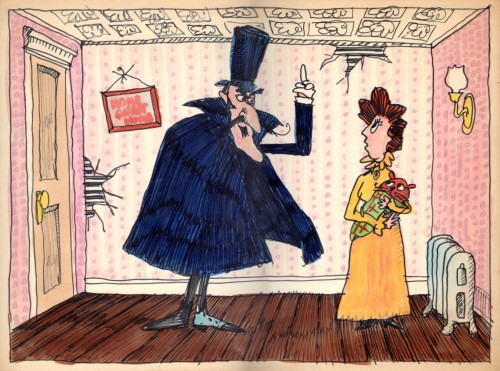
Here is the ad agency’s concept art.
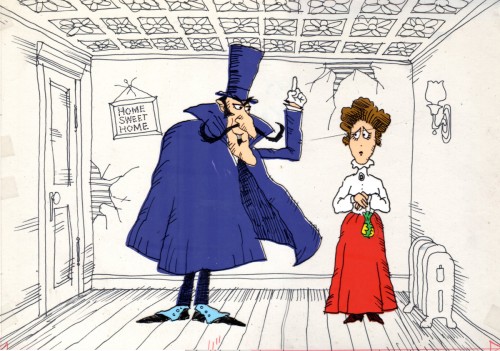
Here’s my tweaking of the agency art design.
This is a cel color model against a line version of the bg.
Next will be my first six rough layout drawings of the spot.
The following are animation key drawings by Jack Schnerk.
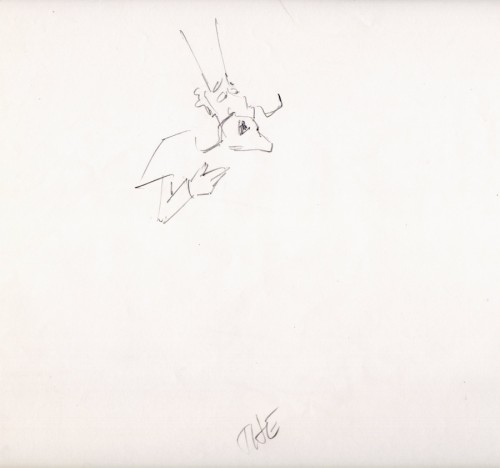 1
1
Once when we were doing designs for a soap bubble character, Jack took a break from animating to do these quick sketches. They are full of life, like all of Jack’s work.
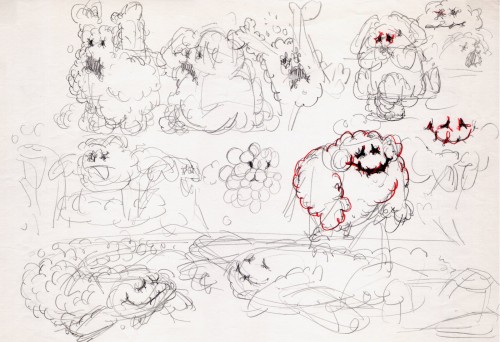 1
1
I hope for those who were fortunate enough to work with Jack, his drawings will bring back some good and happy memories, they do for me!
You can watch this spot on Jack Schnerk Sample Reel 2 starting at 3’01″.
Bill Peckmann &commercial animation &Layout & Design &Models 16 Aug 2012 04:43 am
Weber & Schnerk Vote Toothpaste
Bill Peckmann shared these great LO sketches for one of Jack Schnerk‘s animation samples:
- Since one of the first spots on Jack Schnerk‘s reel was his ‘Dragon’s Mouth‘ Vote Toothpaste commercial, I thought you’d enjoy seeing New Yorker cartoonist Bob Weber‘s key LayOut drawings for the spot. Unfortunately they are not the full color original illustrations but black and white stats that were made to fit in a comfortable field size. These are for the first half of the spot.
These were the only keys that Jack had to guide him on this spot to work his animation magic. It was always a super treat to clean up Jack’s roughs, especially when he animated ‘named’ print cartoonists. The essence of the pose was always there in those terrific sketchy lines and the body proportions were also always bang on!
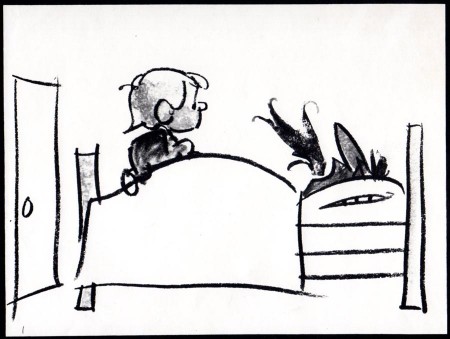 1
1
Bob Weber had a great sense of what to do in animation, his poses are beautiful. You only wish he would have been given more spots to design.
You can also go here and just watch the first spot to see a larger version.
Animation Artifacts &Models &Photos 15 Aug 2012 05:13 am
Another Vince Cafarelli Miscellany
- I continue to weave through the boxes that make up the collection of animation art assembled by Vincent Cafarelli. This week I have anothe rmix of artwork; these pieces were all xerox copies (sometimes copies of copies.) I’ve tried to make them all presentable having to photoshop out some of the schmutz that came with old copiers. Since these are all models and pieces from the 30′s, I thought it worth the trouble.
Let’s start with the mix of models:
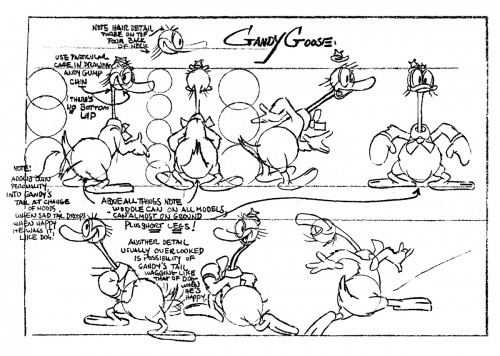 1
1Gandy Goose a Terrytoon character. Not the best quality copy.
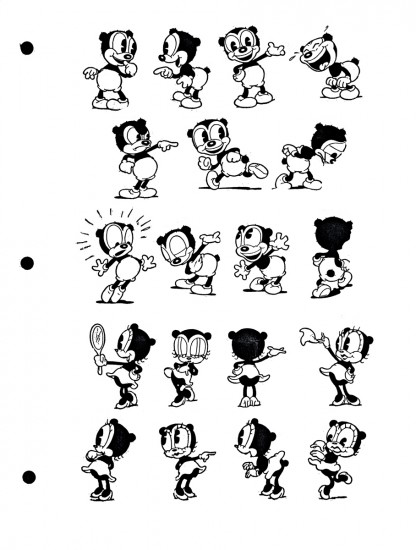 2
2
Cubby Bear, an early Van Buren character
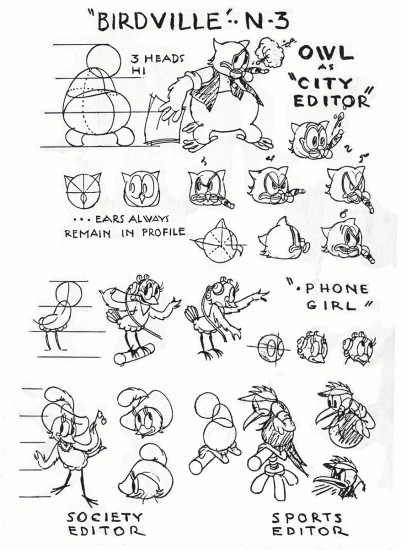 3
3
Parrotville, another Van Buren product from their last years
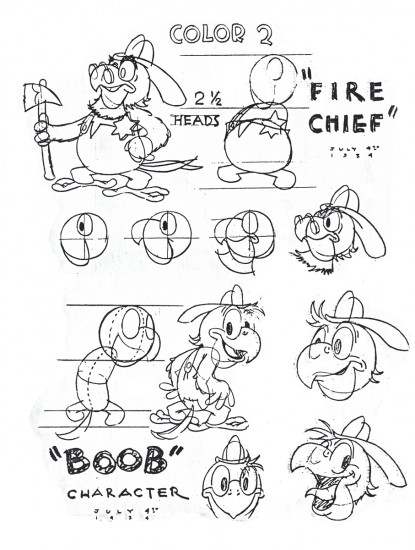 4
4
Another Parrotville model sheet
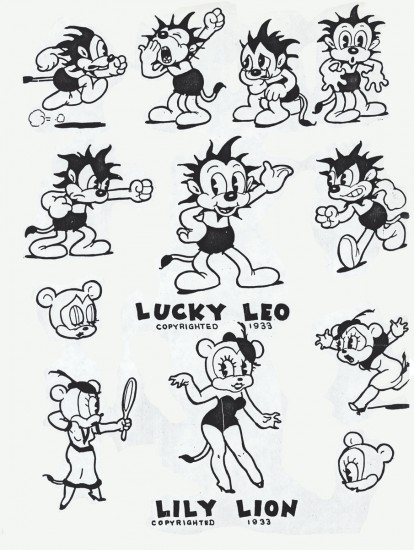 5
5
I have no idea where this character was created,
though I’d bet on Van Buren.
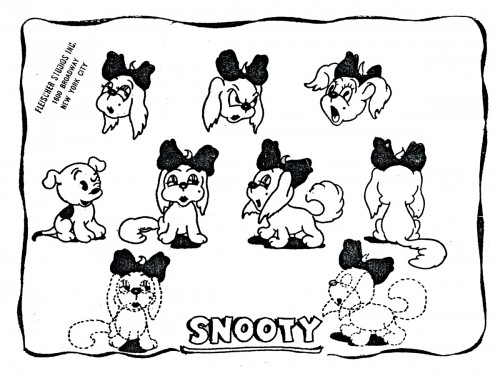 6
6
A Fleischer character to play off Pudgy
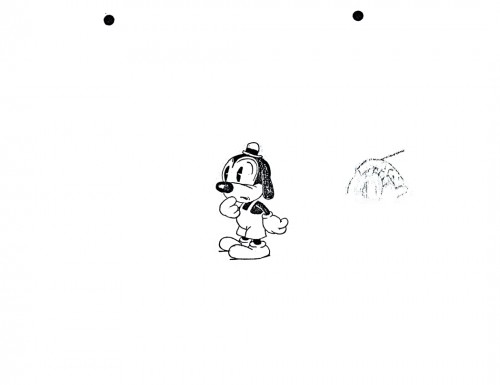 7
7
Another kind of Fleischer dog.
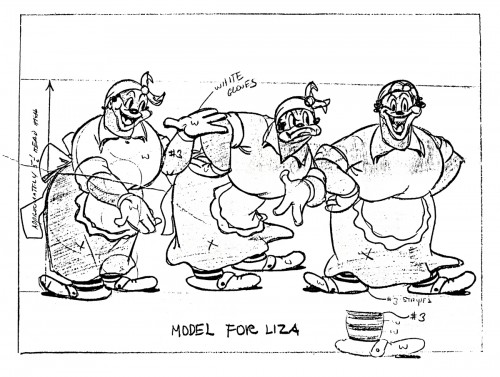 9
9
A typically racist character from Fleischer’s ethnic types.
Here’s a copy of the program from the Paramount theater in New York on their premiere of Gulliver’s Travels.
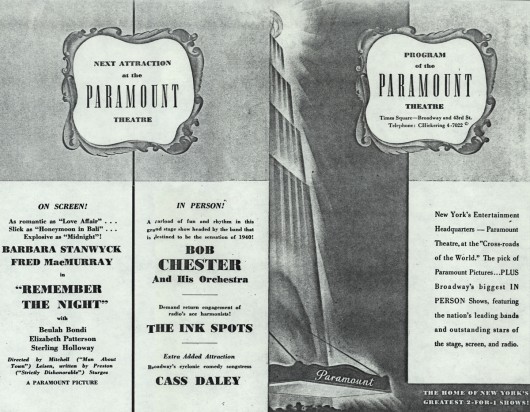
First the outside pages (folded in the center)
To add to the post, I thought I’d throw a random group of photos taken over the years with Vince and Candy at Perpetual Motion/Perpetual Animation or Buzzco.
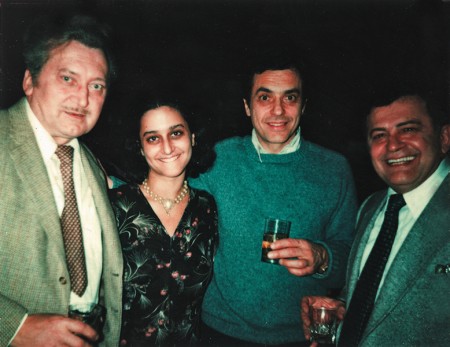
Nick Tafuri’s party for animators
(LtoR) Jan Svochak, Candy Kugel, Vinnie Cafarelli,
And u-nion rep Gerard de Salvio.
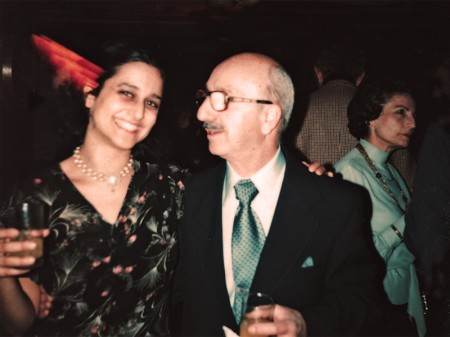
Candy Kugel and Johnny Gentilella and Mrs. Tafuri
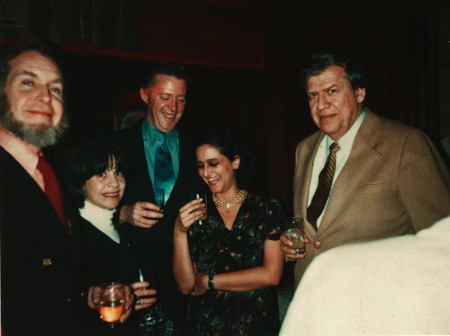
(LtoR) Howard and Iris Beckerman, Doug Crane, Candy Kugel and Ed Smith
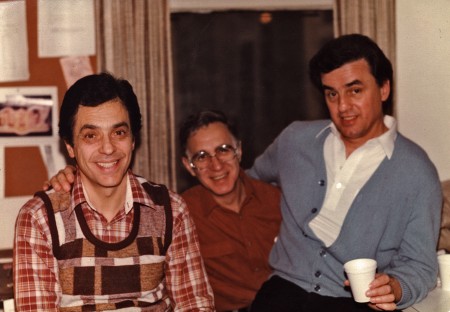
Perpetual Motion Pictures:
(LtoR) Animators Vinnie Cafarelli, Jack Dazzo and Vinnie Bell
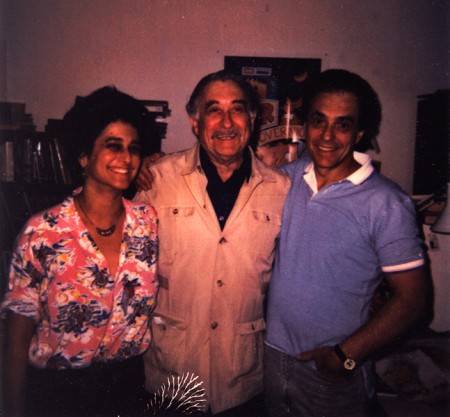
Buzzco: (LtoR) Candy Kugel, Lu Guarnier, Vinnie Cafarelli
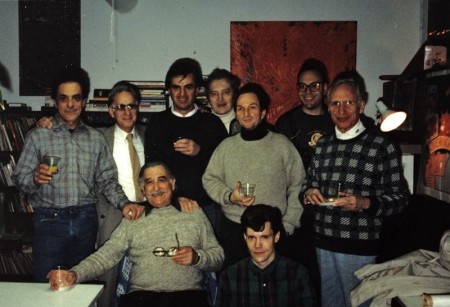
Buzzco: (LtoR standing) Vince Cafarelli, Jack Dazzo, Vinnie Bell,
Jan Svochak, Arnie Levin, John Lopez, Max Seligman
(seated) Lu Guarnier, Bryon Moore
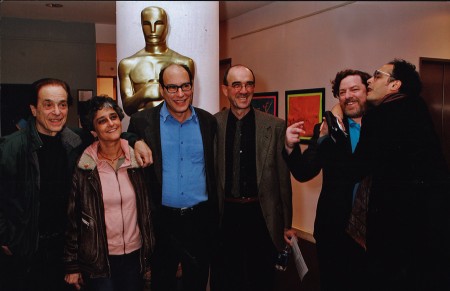
Some NY animation Academy members:
Vince Cafarelli, Candy Kugel, Jimmy Picker,
Frank Mouris, me and John Dilworth
Commentary &Puppet Animation 14 Aug 2012 03:48 am
ParaNorman Screening and Talkback
- This past Sunday at 10am there was an industry screening of ParaNorman at a theater two blocks away from my home. I’d planned to go. I was asked to moderate the talkback, a Q&A with the directors of the film: Chris Butler and Sam Fell. Naturally, I said yes.
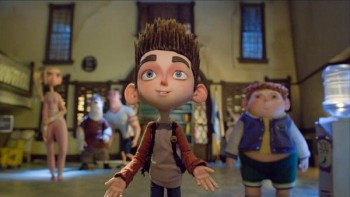 – Heidi and I arrived at 9:30; there was a bit of a line outside the theater. I was told to ask for Kia Muhammed of Focus Pictures. The doors to the theater were locked, so we had to wait until someone arrived to let me in and bring me to the Focus front desk. No other films were screening this early, so there weren’t many other places to go.
– Heidi and I arrived at 9:30; there was a bit of a line outside the theater. I was told to ask for Kia Muhammed of Focus Pictures. The doors to the theater were locked, so we had to wait until someone arrived to let me in and bring me to the Focus front desk. No other films were screening this early, so there weren’t many other places to go.
I wanted to be prepared to find out how long the talkback would be; would there be mikes for the three of us as well as for audience members who were going to ask questions. I learned that they’d planned for a smaller theater but were given the one we got. That meant they cut off the front section and planned to put three tall stools there for us to sit and for me to ask questions. Easy. I’d planned on getting a bit of background information from the two directors about the genesis of the film as well as their backgrounds. Then I’d open it up to the audience’s questions.
But first the film.
The Babcock Family
Grandma, Mom, Dad, Norman and Courtney
Laika, the producers of this 3D stop-motion film had first done Coraline under the direction of Henry Selick. Amusing that Coraline was on cable tv this morning just prior to the screening. I stopped and watched a couple of minutes. There’s some beautiful animation in that film, but in some ways it also felt limited in its animation.
I’m not sure if there was a bit of a projection problem, but we had no picture at first, just triumphant logo music. It then cut into a smaller screen mock-low-budget zombie flick. It didn’t take long to realize that Norman was watching it on tv with his grandmother – his dead grandmother. Apparently Norman could see dead people. We learn that he gives more attention to them on his walk to school than he does to the real people on the street who just stare at the strange child.
Norman, it turns out, is being bullied at school for being a bit strange, and he has only one friend. The fat kid, Neil. These characters are beautifully developed as are many of them in the film. I also liked the voices quite a bit. Just looking over the cast, I was surprised to see John Goodman’s voice on the list. He does a bit of acting this time out, so that’s a pleasure to hear his character. I recognized Jeff Garland’s great voice as Norman’s father, but I didn’t recognize Elaine Stritch as his grandmother. I’m not the biggest fan of her work. She normally chews the scenery in overacting everything she does, but I think she did a great job here.
Norman with the John Goodman character
The animation was superb. Everything seemed to be on ones and beautifully fluid. There were a lot of peculiar and erratic moves that seemed totally natural to the characters on screen. The directors told us there were a number of scenes, particularly crowd shots that had some cg characters added since it would make the FX work much easier.
The climax of the film involves a lot of FX as the witch’s curse is brought to a close so that the dead, seen by Norman, can go back to rest. Very arresting imagery here makes it strong visually.
My only problems with the film had to do with the story. I found it sagging quite a bit midway. The emotional wallop isn’t strong enough because everything for some time seems to be at an even pace. I would have liked to see it vary a bit more, heightening and lightening throughout. This is the hardest part of filmmaking; it’s something I have my own problems with, and I think it changes with experience.
I enjoyed this film more than Coraline, and I think they’re onto something with the stop-motion animation. There’s a tactile sense to the film that you never get with cg. I’d recommend it, and I think it’ll do well.
As the credits started to roll, I went outside to meet the two directors. I told them basically what I would be asking about and asked if there was anything they wanted to get across. From there we went inside to our appointed seats and microphones. The microphones, of course, turned on but didn’t work. We just spoke loudly, and I instructed the audience to do the same when they asked a question.
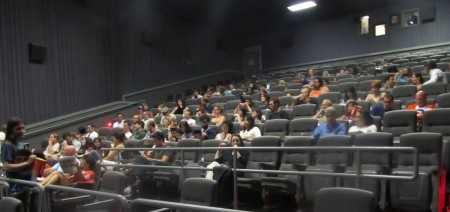
Half the audience in that kind of uncomfortable theater
They kept the lights on the audience down low, and the lights up front, where we were, a bit brighter, though I learned we were basically in the dark.
We got into it. Midway through the conversation the house lights went on, and I knew we’d soon hear our voices booming. Sure enough, the mics turned on, squealing across the theater. We just shut off the mics and resumed talking in our natural voices.
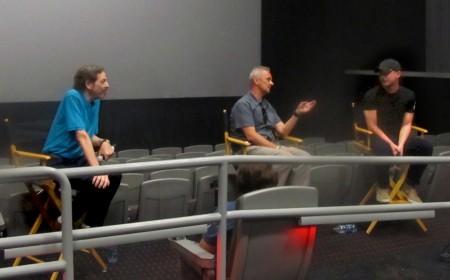
(L to R) me, Sam Fell, Chris Butler
Chris Butler was the sole credited writer, so I asked about the script. He, apparently, had started it while he was working in the story department on Coraline. He got the chance to show it to Travis Knight and sold the script as their next film. From his vantage point there was no break between the two features. Sam Fell, who’d started animating for Aardman got to direct Flushed Away and The Tale of Despereaux. From there he met with Chris Butler. The two hit it off, and they got to work together on ParaNorman.
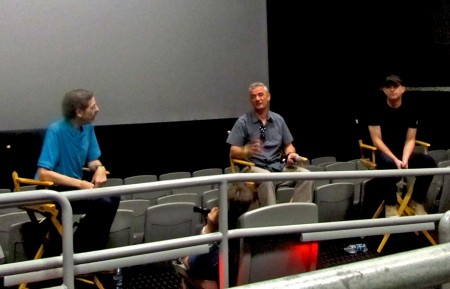
(L to R) me, Sam Fell, Chris Butler
I asked what differences had happened to stop-motion animation in the recent past since we’re no longer doing the clunky animation of Alice in Wonderland anymore. He talked about playback, photography, replacement faces (which are printed out from computers so that the animation is much smoother) and apparently, they do rehearsed versions of the scenes, whether on 2s or 10s, sort of an animatic rough of the scene, so that the director will know exactly where they’re going. Digital was the magic word to make the stop-motion animation better,.
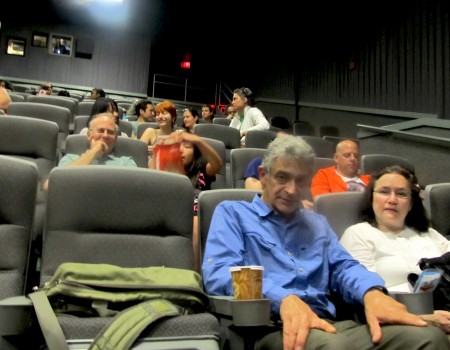
the other half of the audience
The questions from the audience typically ranged from good to dumb. Bill Plympton asked what it was like directing animation from Travis Knight, their boss. They said they didn’t have to be critical since he was a very talented animator who usually did his rehearsals on 2s. Someone else asked the budget, and they said they really had no knowledge of that aspect. (What else should they have said?) There were a number of questions about the replacement faces that were printed by computer, and other questions asked about the sets – how many and how large.
Basically, the directors were friendly, courteous and pleased to be able to talk about their work. I think they’ll have something of a hit on their hands.
Aside from all the other press material available on line, there’s a nice slide show on the NYTimes site as well as an article about the making of the film.
There were many others from our local talent at the screening. Admittedly I wasn’t paying much attention since I had the talkback on mind. Here are a few of those there that I can roll of the top of my head; they included Candy Kugel and husband, Chuck; John Dilworth and girlfriend, Marie; Bill Plympton and wife, Sandrine; Signe Baumane with a couple of her interns; and Jaime Ekkens.
Animation &commercial animation &Frame Grabs &Hubley 13 Aug 2012 05:28 am
Hubley Bumper – recap
- Last week, Emily Hubley told me that some people up at WNET (previously WNDT), the local PBS chapter, saw this piece on my blog. They were hoping to get copies of the Hubley spots to show in celebration of their upcoming 50th anniversary. It’ll be great to see these films alive again.
Here’s my post on a couple of the films.
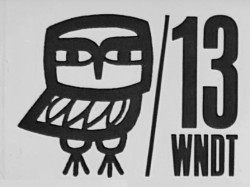 - One of my all time favorite pieces of Hubley animation was a station ID for WNDT-TV, New York’s public service station back in the 60′s. I thought of this spot last week when I posted the piece about Stanley Kaufman’s Art of Film for that station. It ultimately became WNET, NY’s PBS channel 13.
- One of my all time favorite pieces of Hubley animation was a station ID for WNDT-TV, New York’s public service station back in the 60′s. I thought of this spot last week when I posted the piece about Stanley Kaufman’s Art of Film for that station. It ultimately became WNET, NY’s PBS channel 13.
This spot was undoubtedly animated by Bill Littlejohn, and I think it’s one of his finest pieces. The timing is excellent. He obviously animated straight ahead; the characters distort and morph to the needs of the animation. It’s a full 2mins: 40 secs, so it would qualify as a short film these days,
The piece ran in B&W. It employed the multiple exposure technique. The characters had black paint filling everything but the animation drawing. This was double exposed over the BG, hence a see-through quality to the characters. This technique was used on Moonbird, The Hole, Of Stars and Men and several other Hubley shorts.
Here are some frame grabs of the spot.
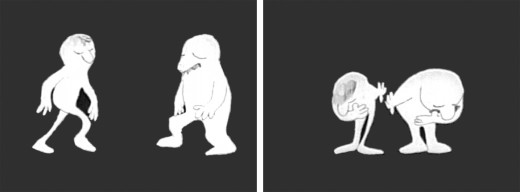
The two guys come out on to the stage and take a bow.
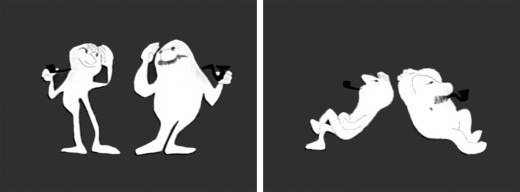
They greet each other, light up and sit down.
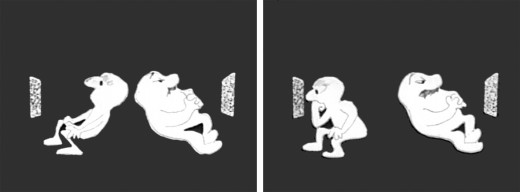
A little bored, they both turn on TV’s. The little guy gets involved.
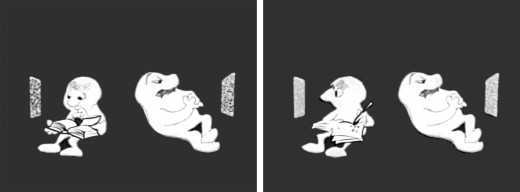
He takes out a book and takes notes comparing it with what’s going on his TV.
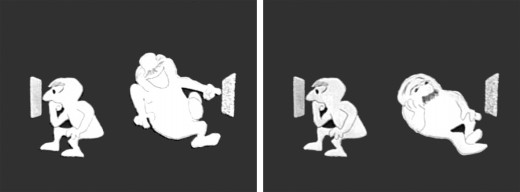
He goes back to watching. The big guy laughs at something until he gets bored again.
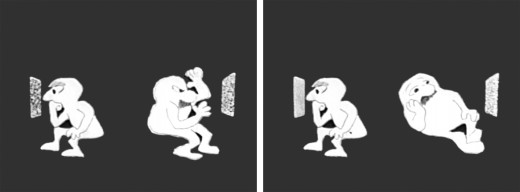
The big guy practices some wrestling moves until that gets dull.
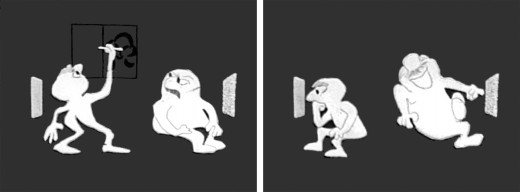
Little guy does some brush painting. Big guy laughs again.
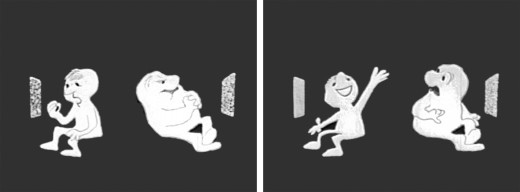
Little guy practices Russian. The big guy gets annoyed.
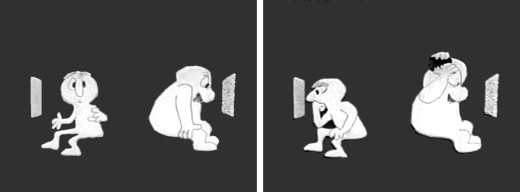
The big guy takes out a comb and starts combing until . . .
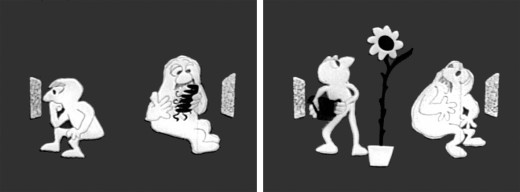
.. he has grease all over his head. The little guy grows a plant.
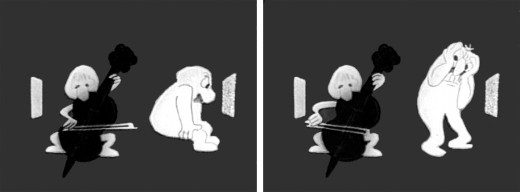
The little guy takes out a cello and starts to play. This annoys the big guy.
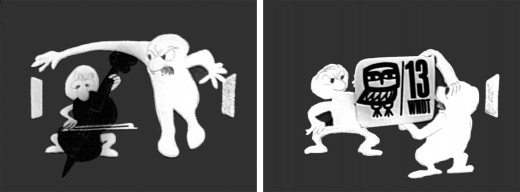
He pulls up the little guys screen. Public Television !

Embarrassed, he bows to the “Arts” station.
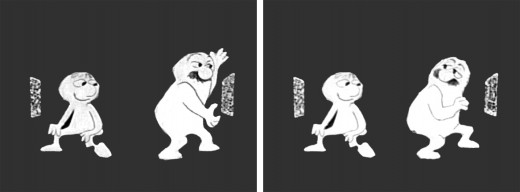
He turns to it on his own TV. He’s planning for something great.
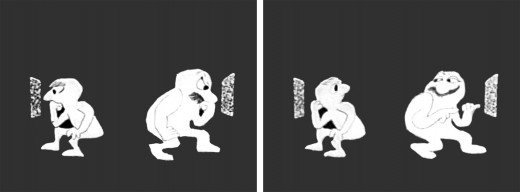
They watch intently until the big guy makes sure little guy knows he’s still watching.
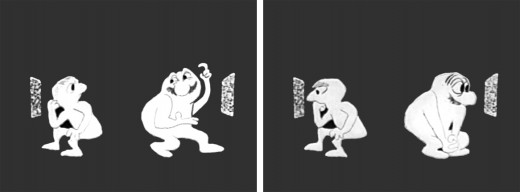
“Brain food” They watch intently.
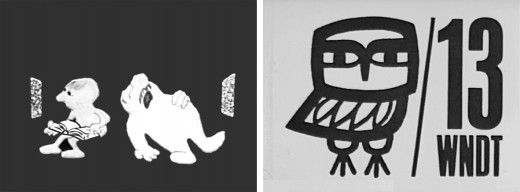
The big guy falls asleep while the little guy goes back to his book. Dissolve to station card.
I love how the shapes of the characters shift and distort and change throughout the piece always coming back to the original models. This is a sure sign of straight ahead animation, and it almost makes the acting feel like an improvisation exercise by two actors. It supercedes animation and becomes acting.
The obviously loose time of the piece shows that the animator was probably given a lot of leeway with his timing, and he took it. As I said, I have no proof that Bill Littlejohn animated it, but I’ve never doubted it for a moment. It’s certainly as much his style as it is Hubley’s.
That is the odd thing about working for a director with a strong personality. I remember the day that I looked at one of my drawings and realized that it looked like one of my drawings, but there was no doubt it was a Hubley. Something happens, and you just end up drawing in their style.
